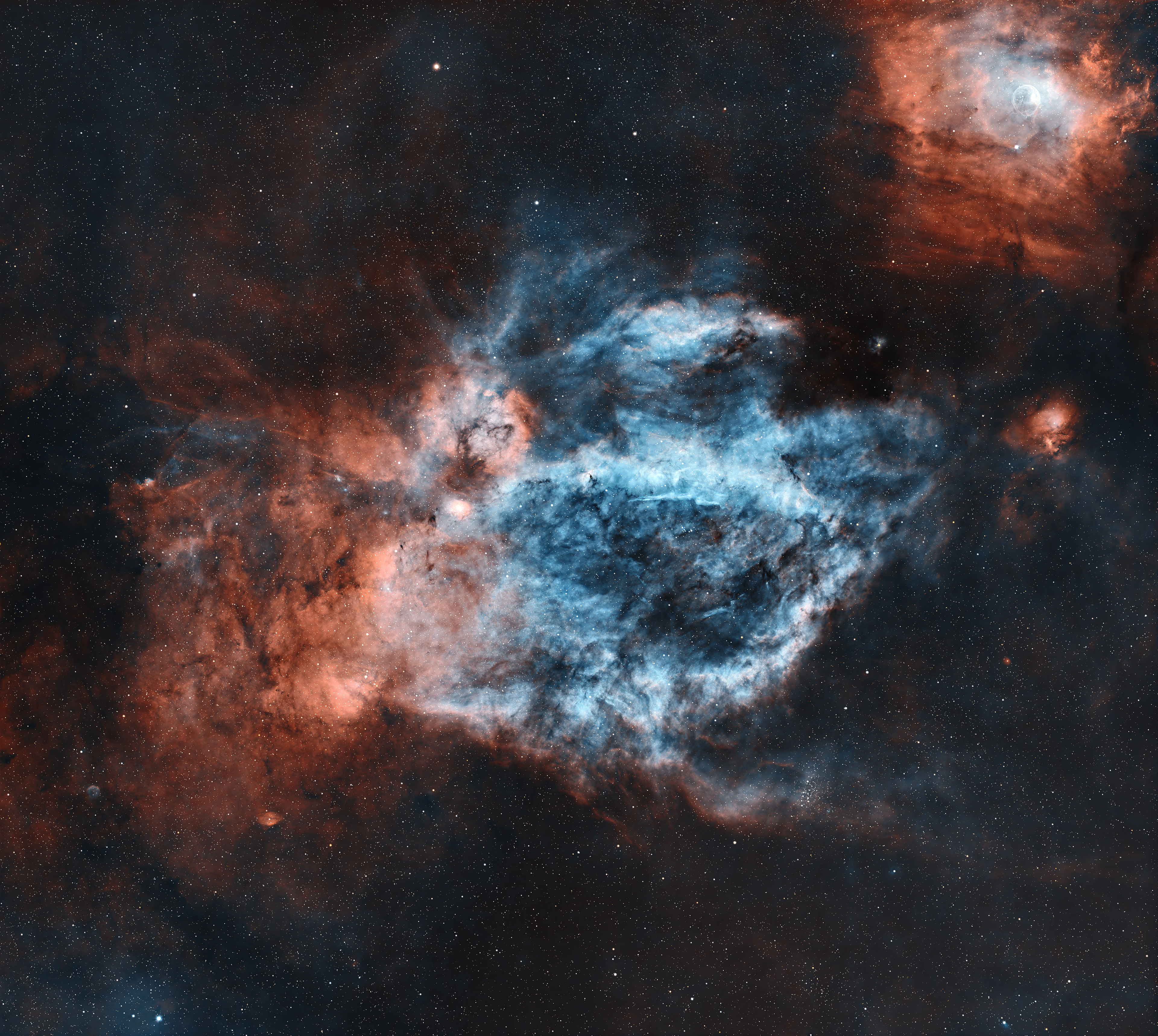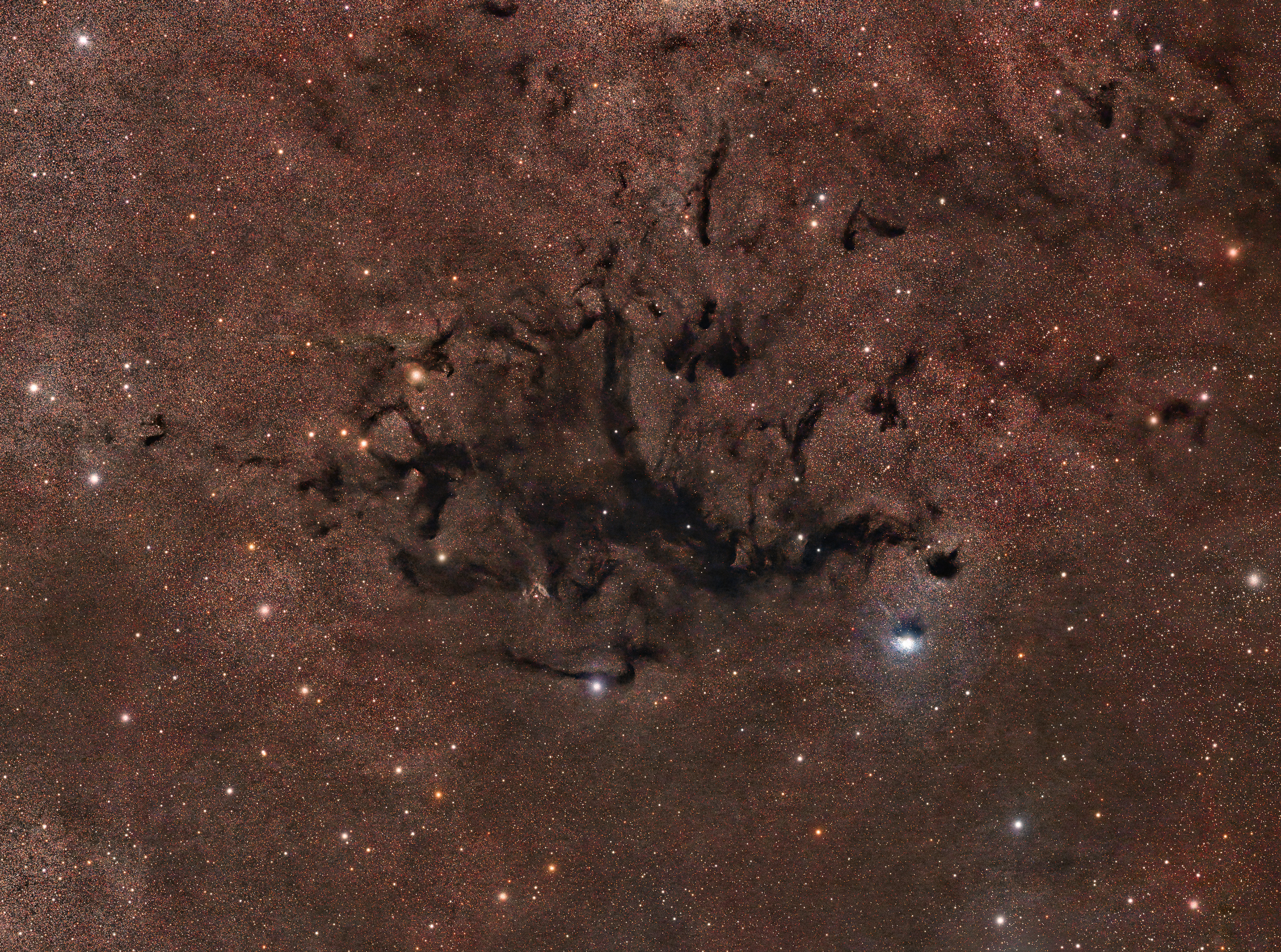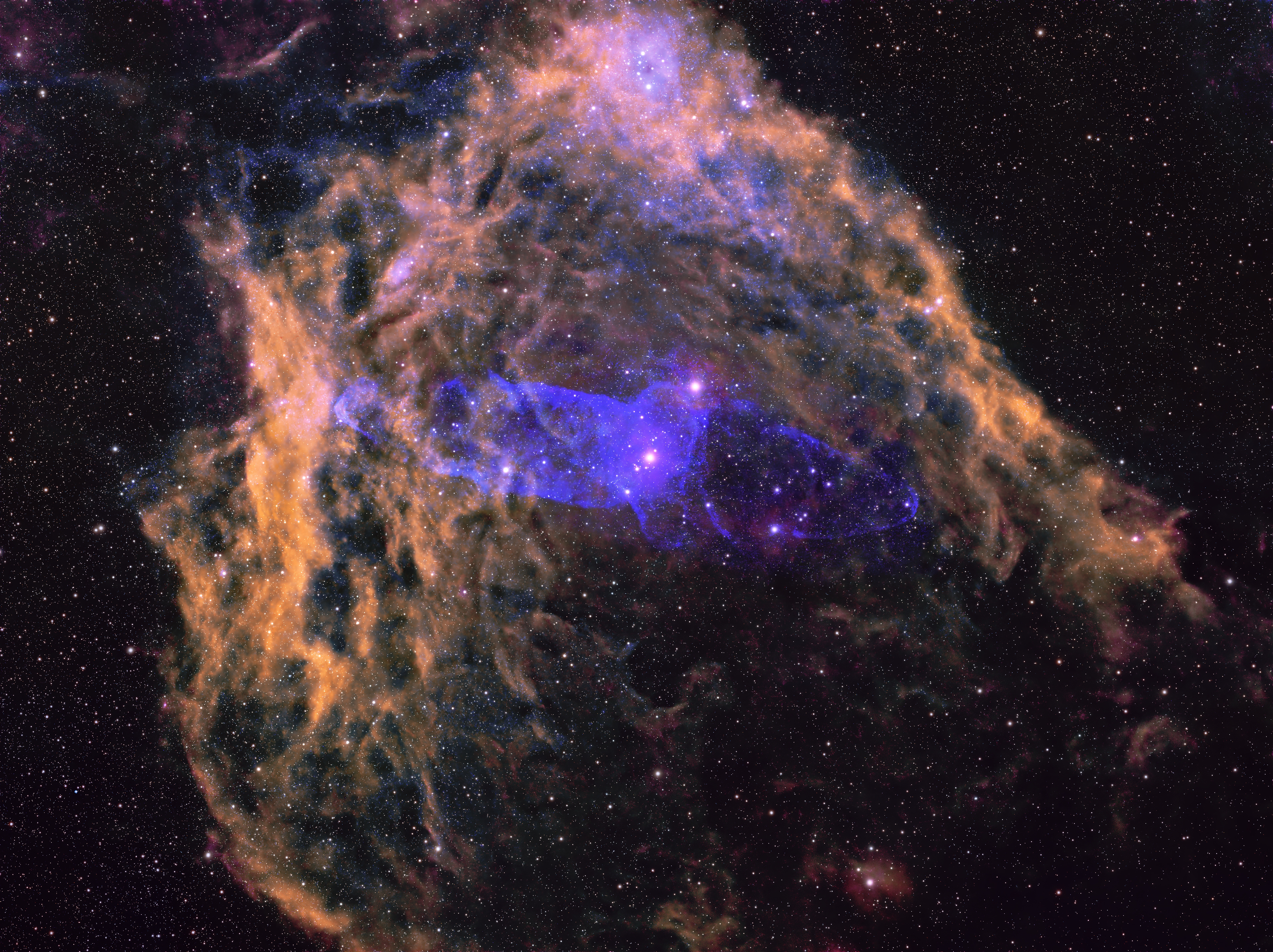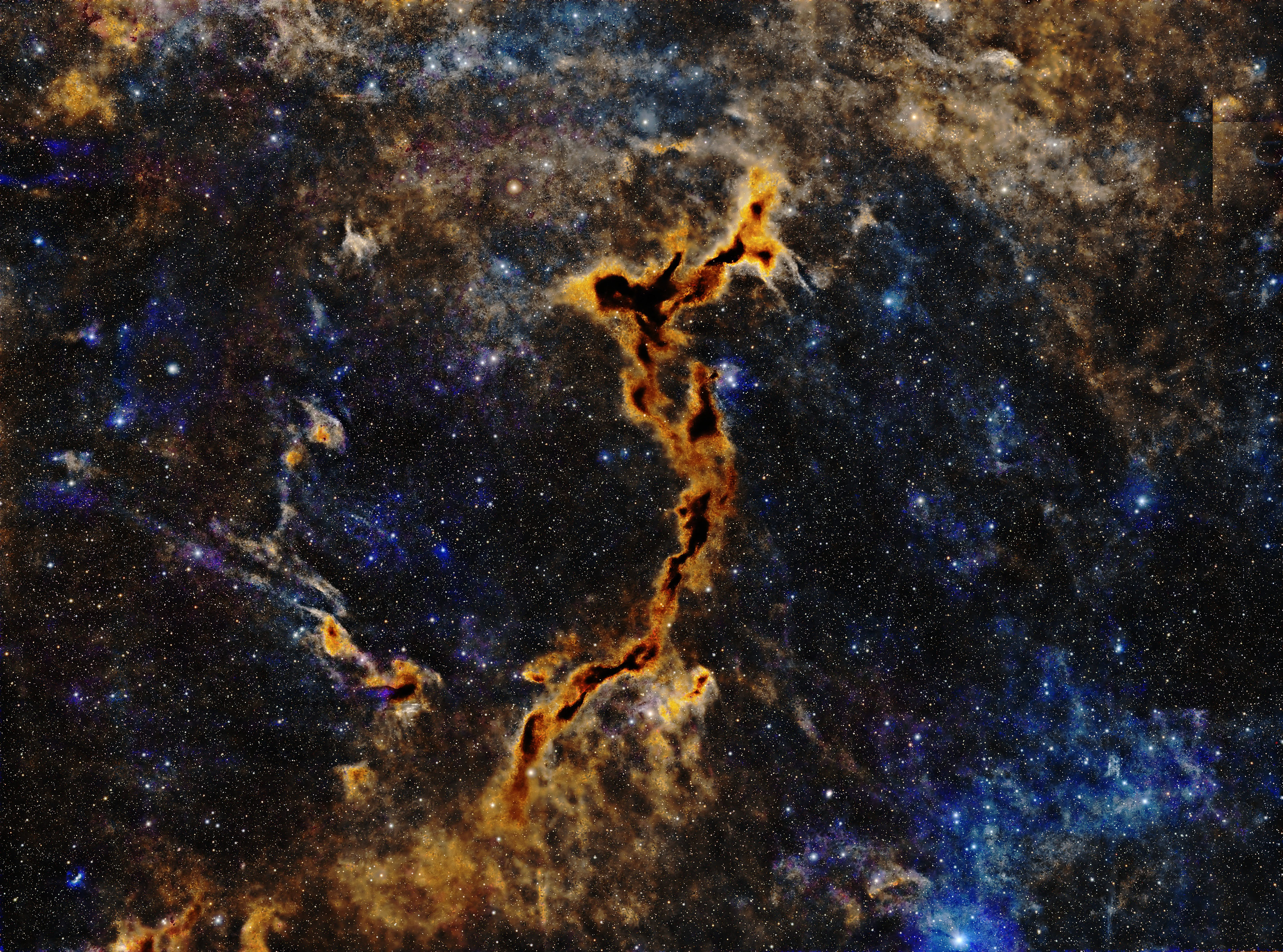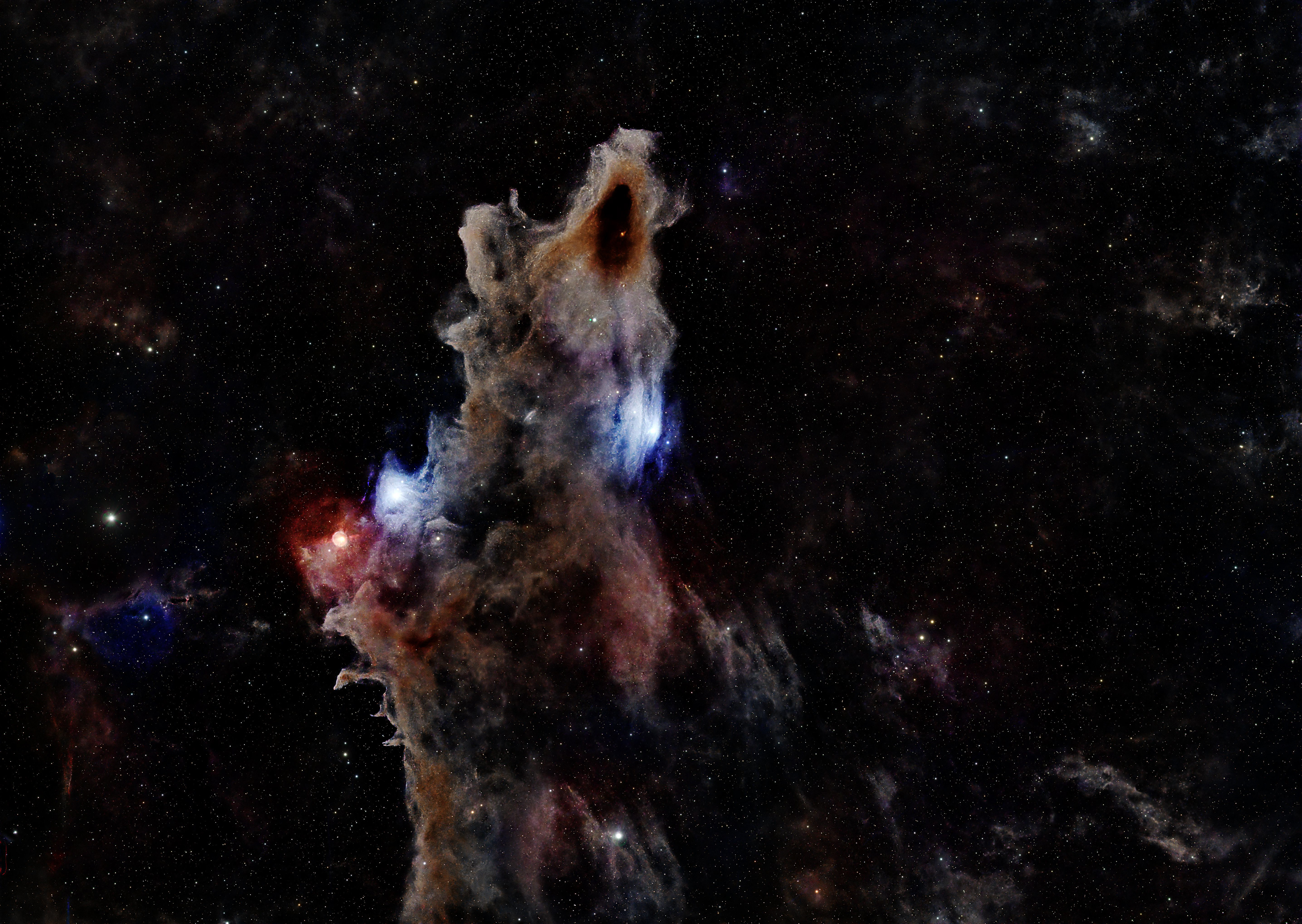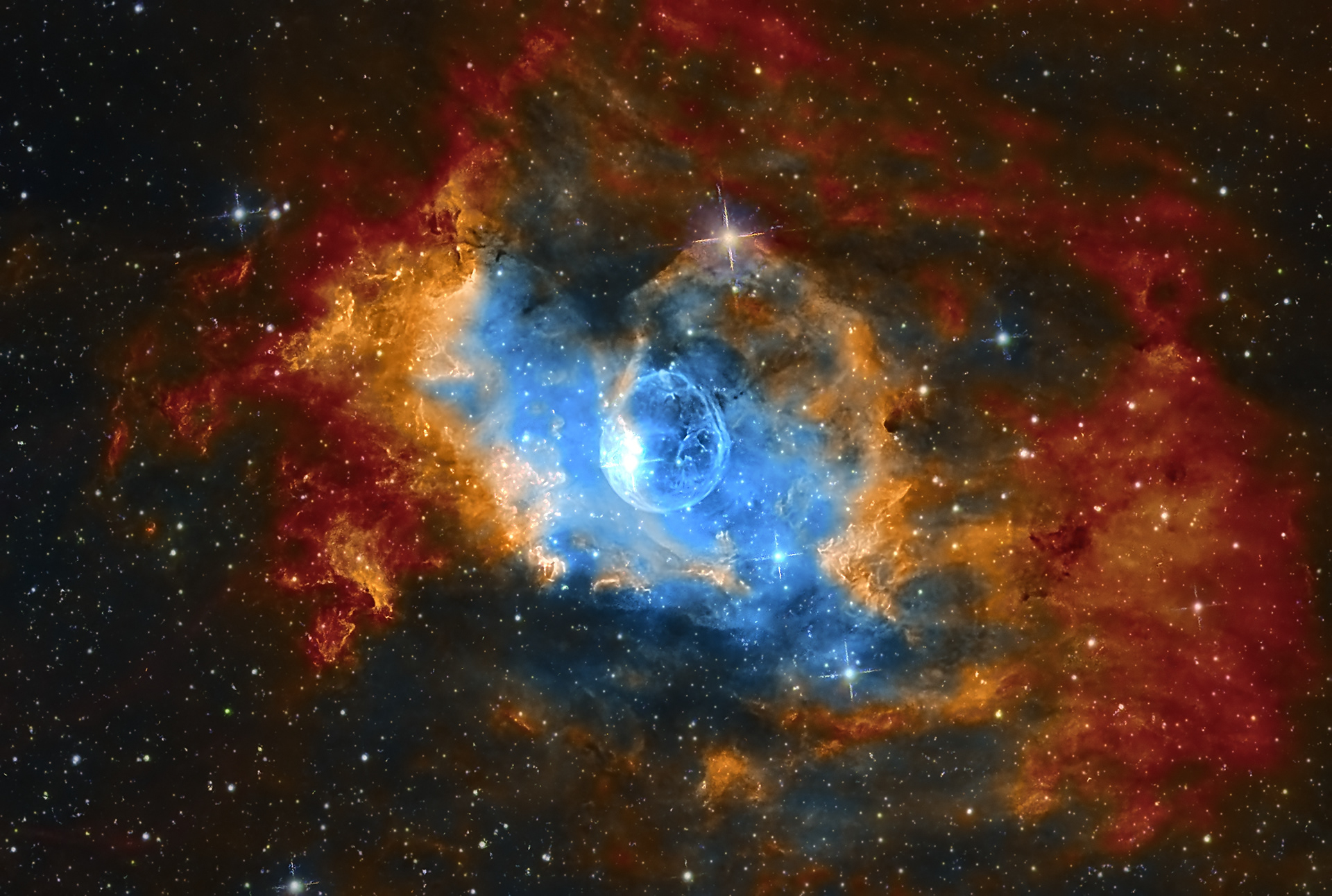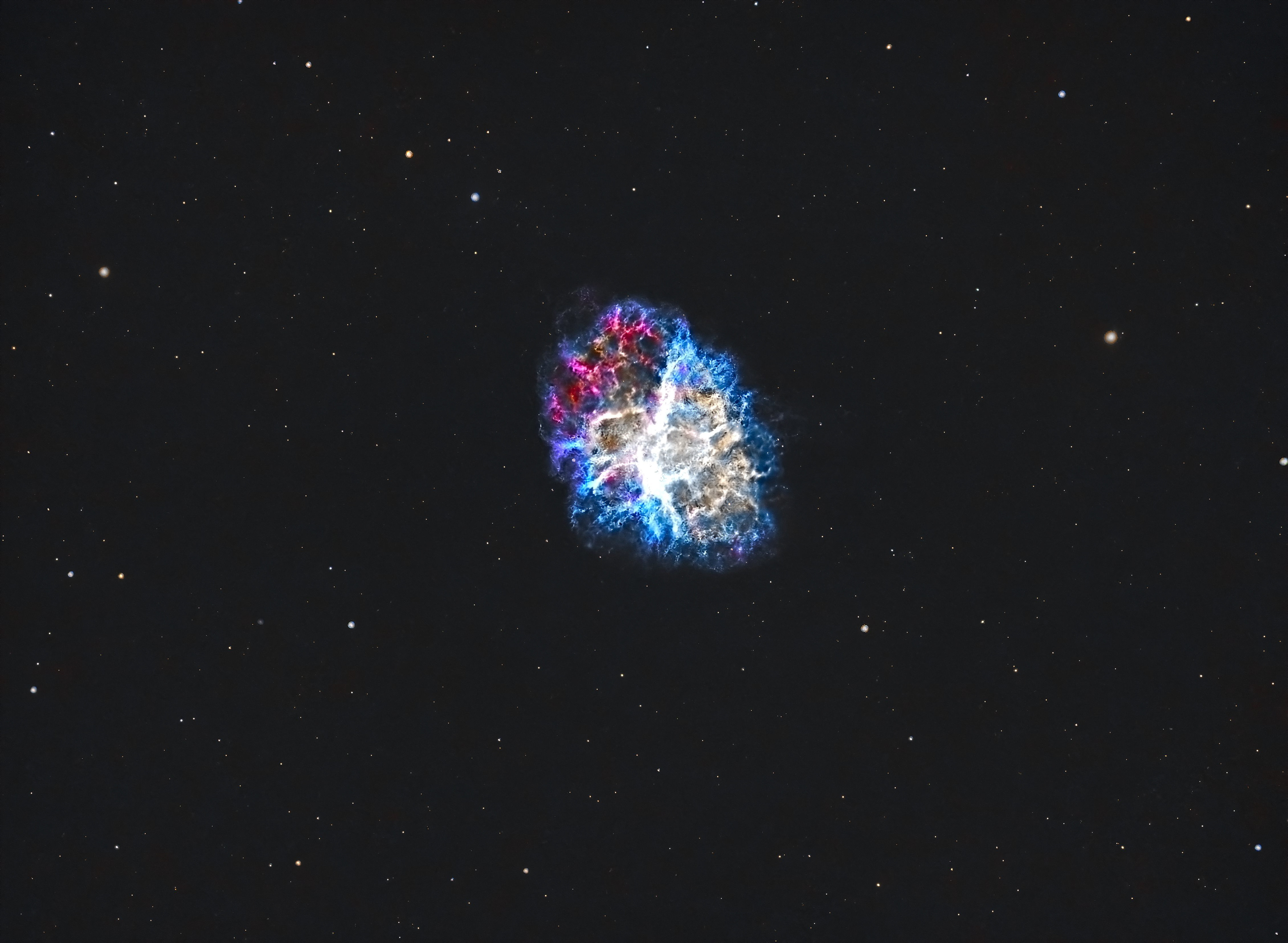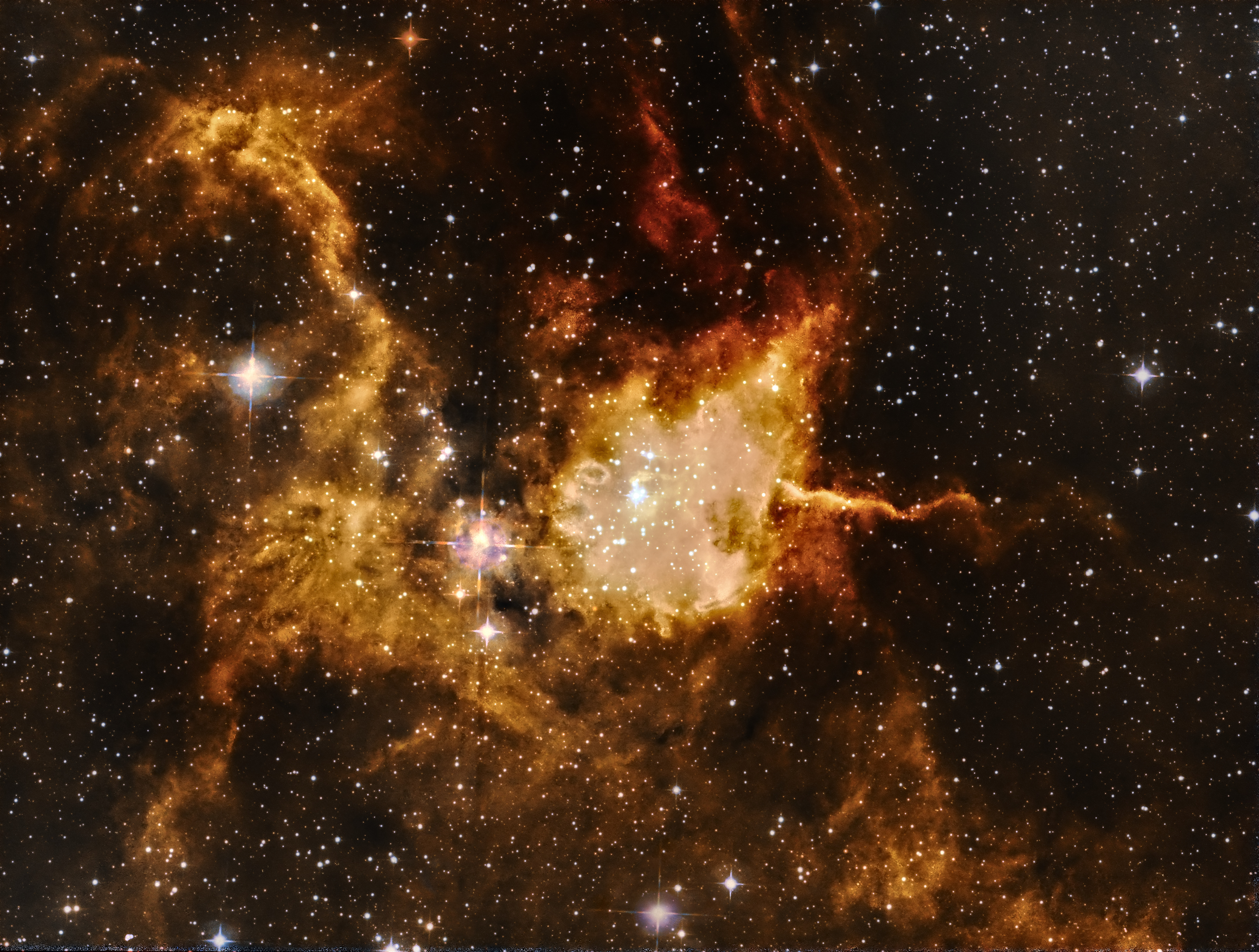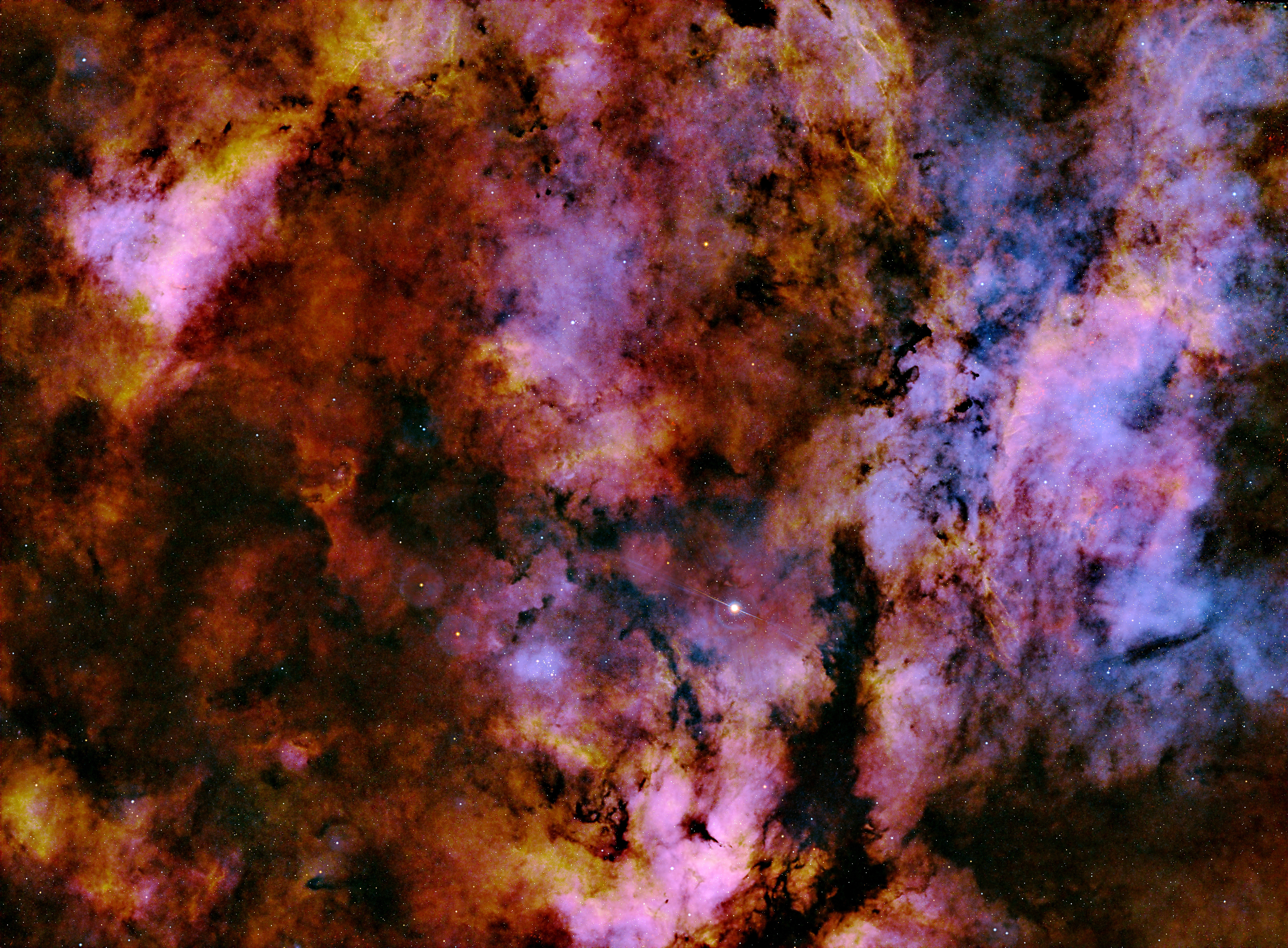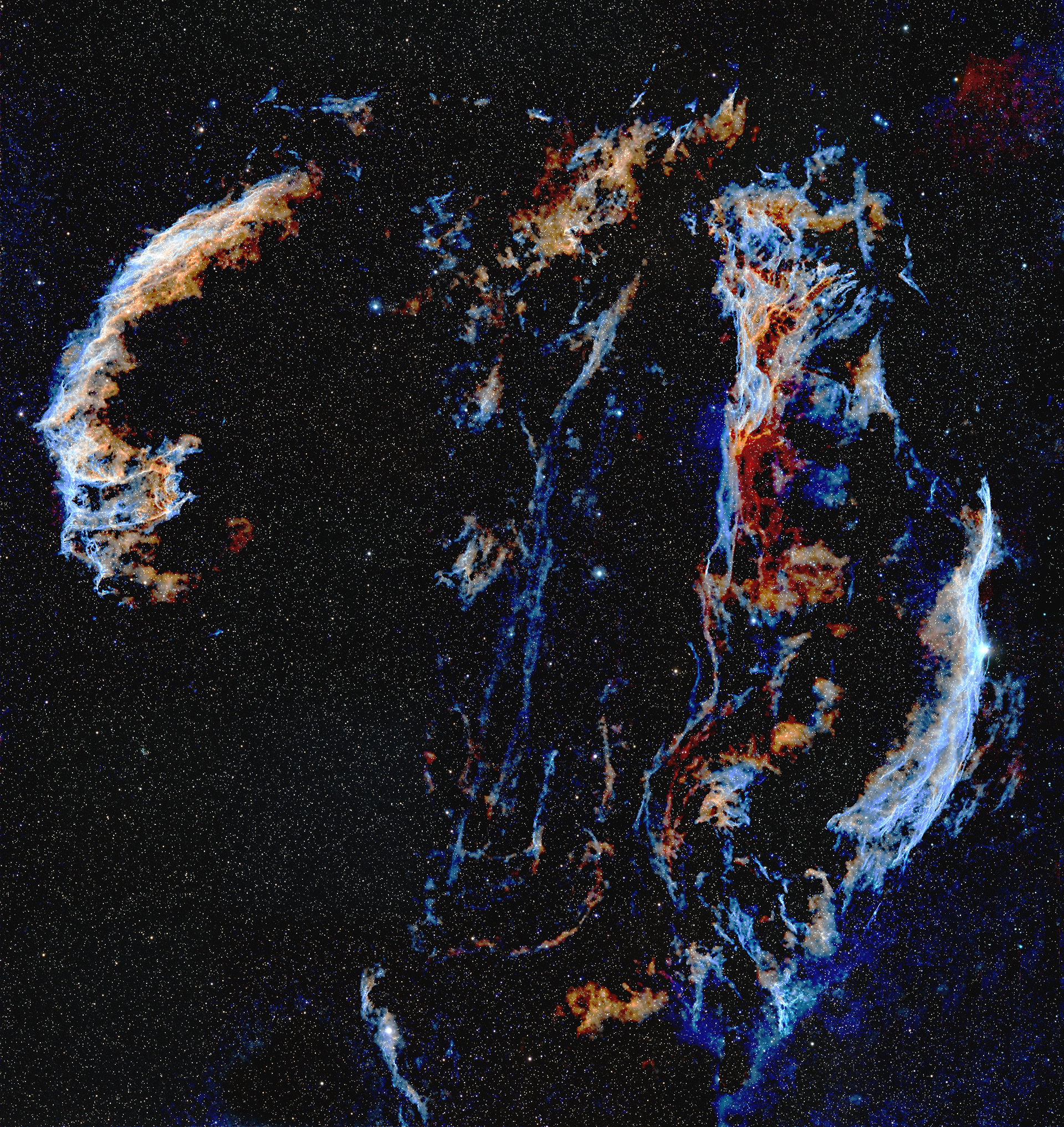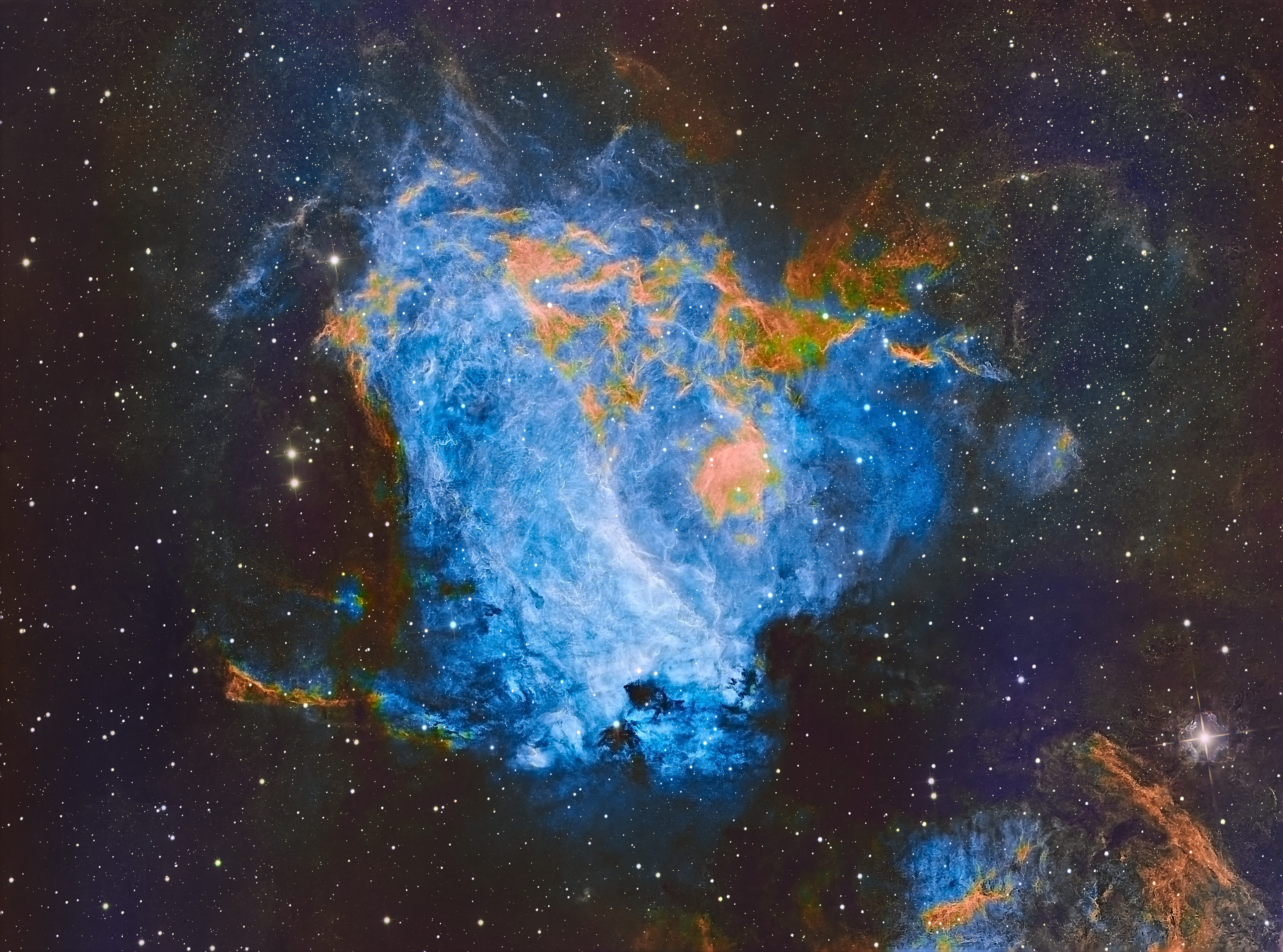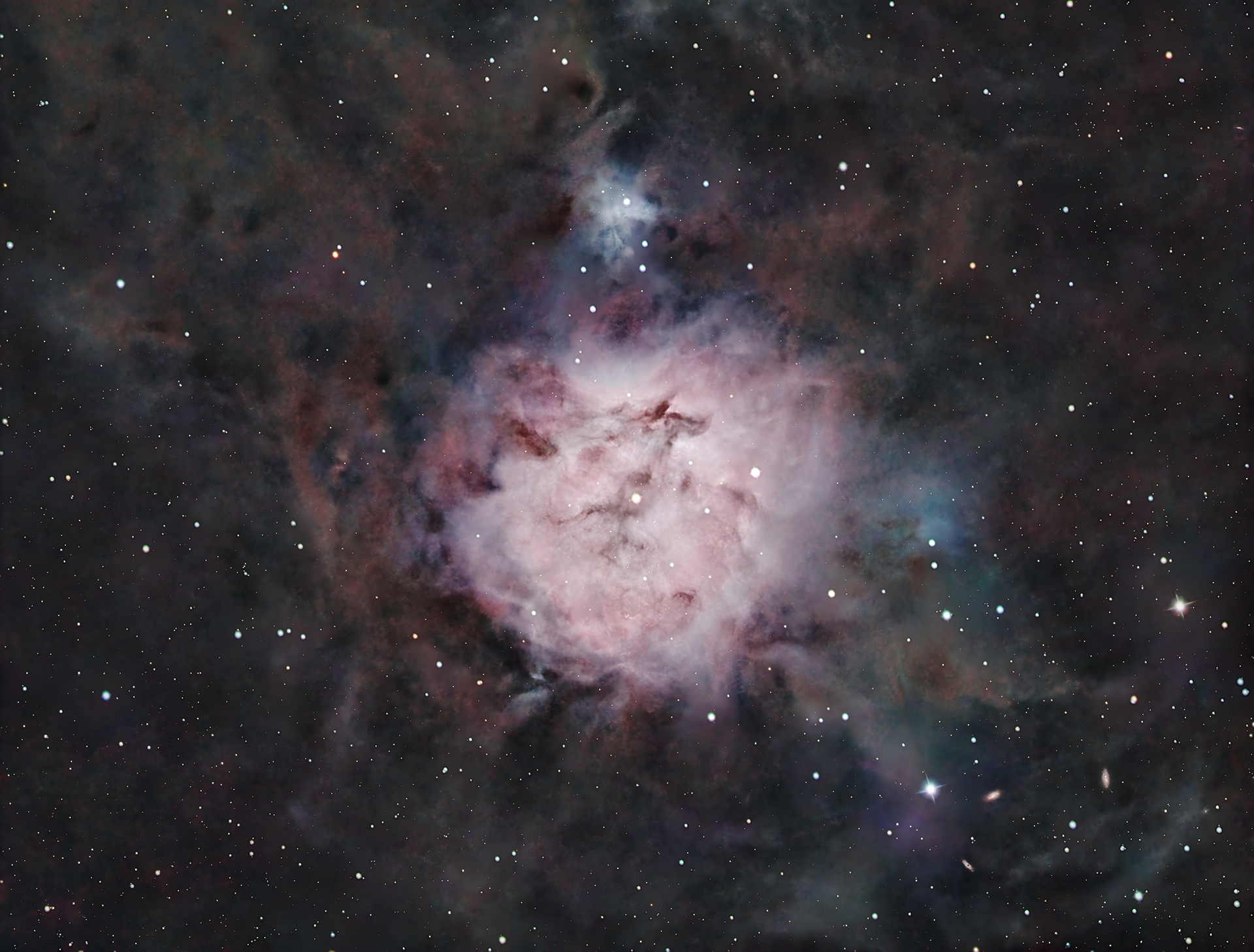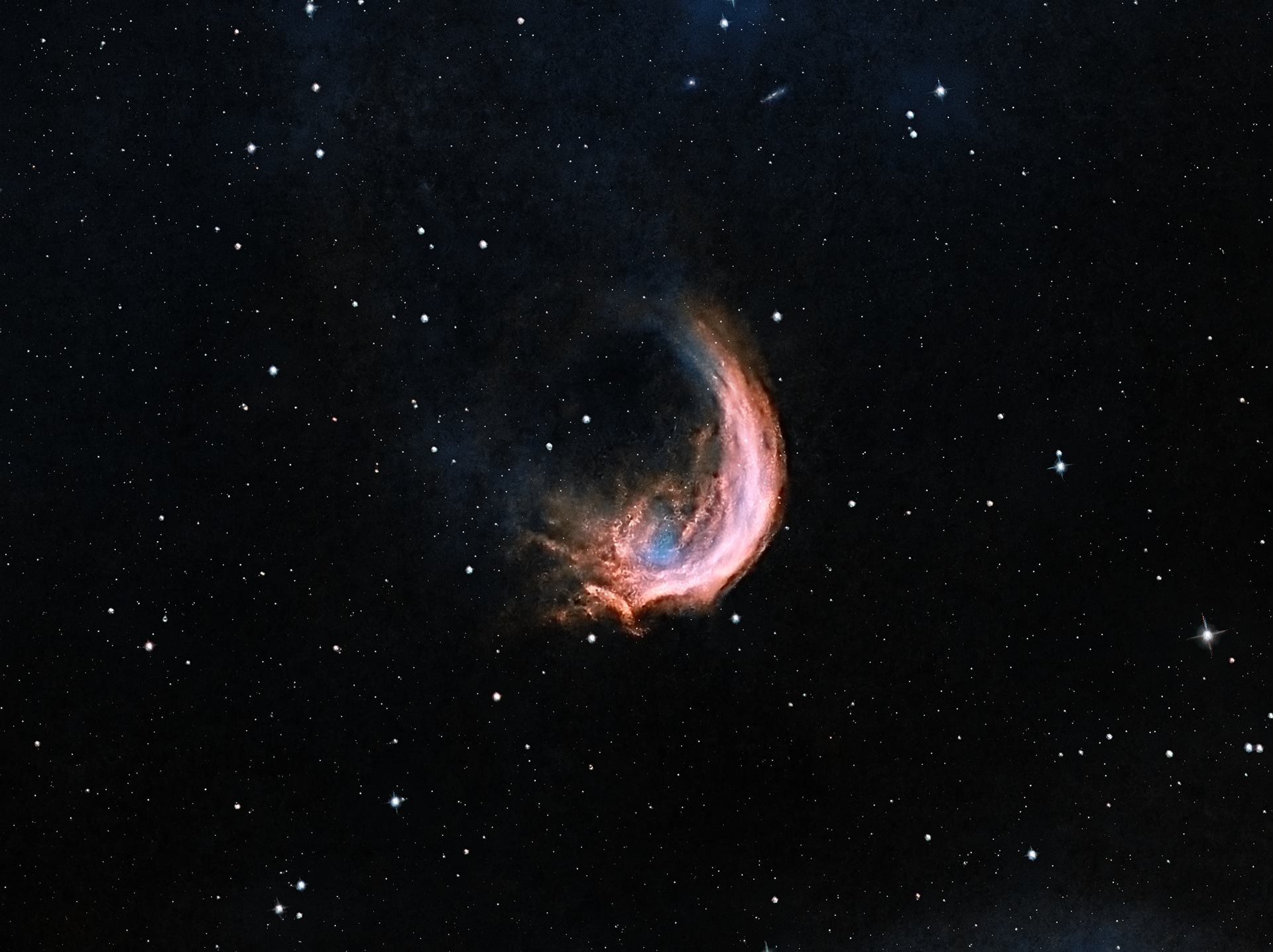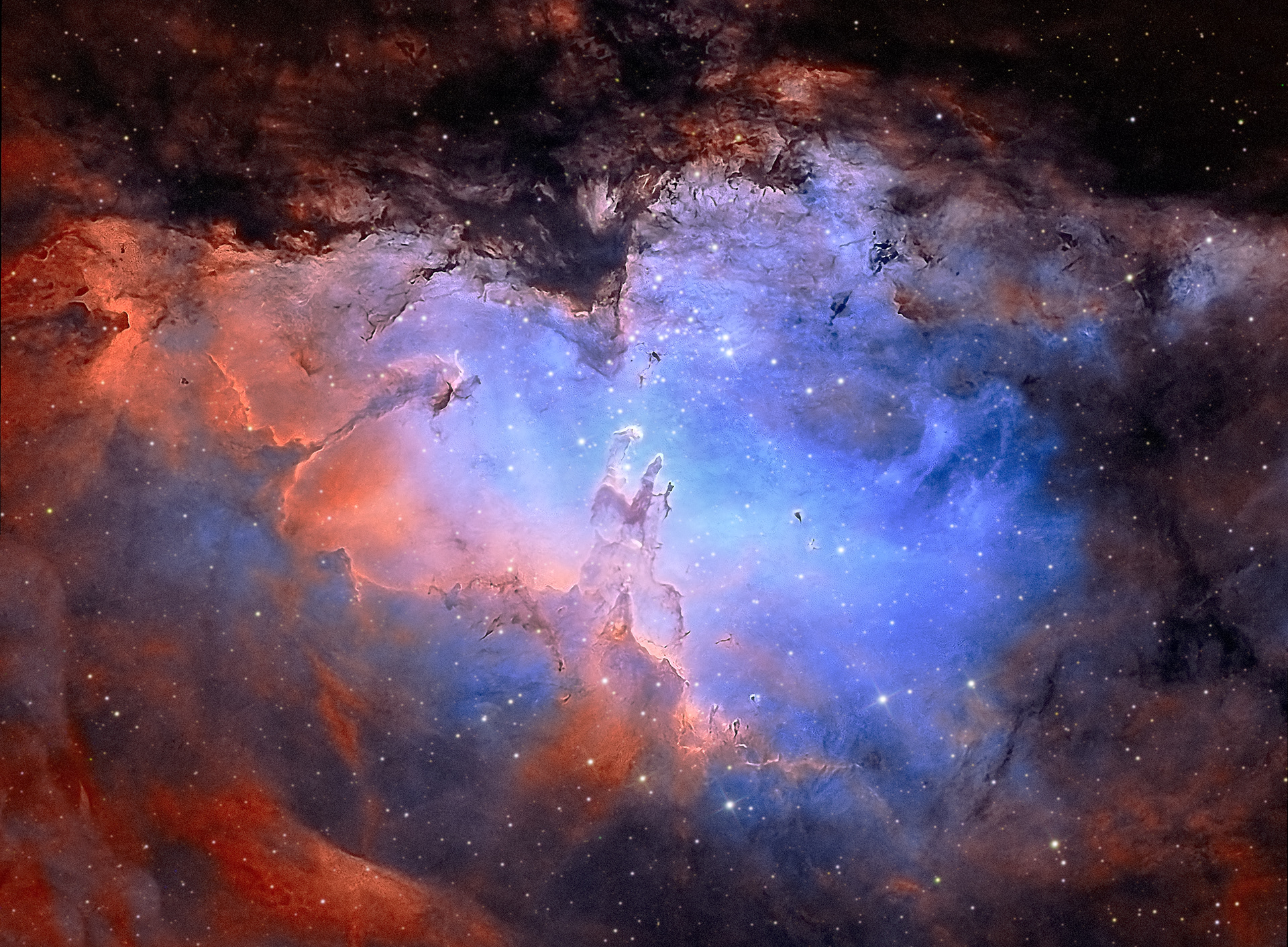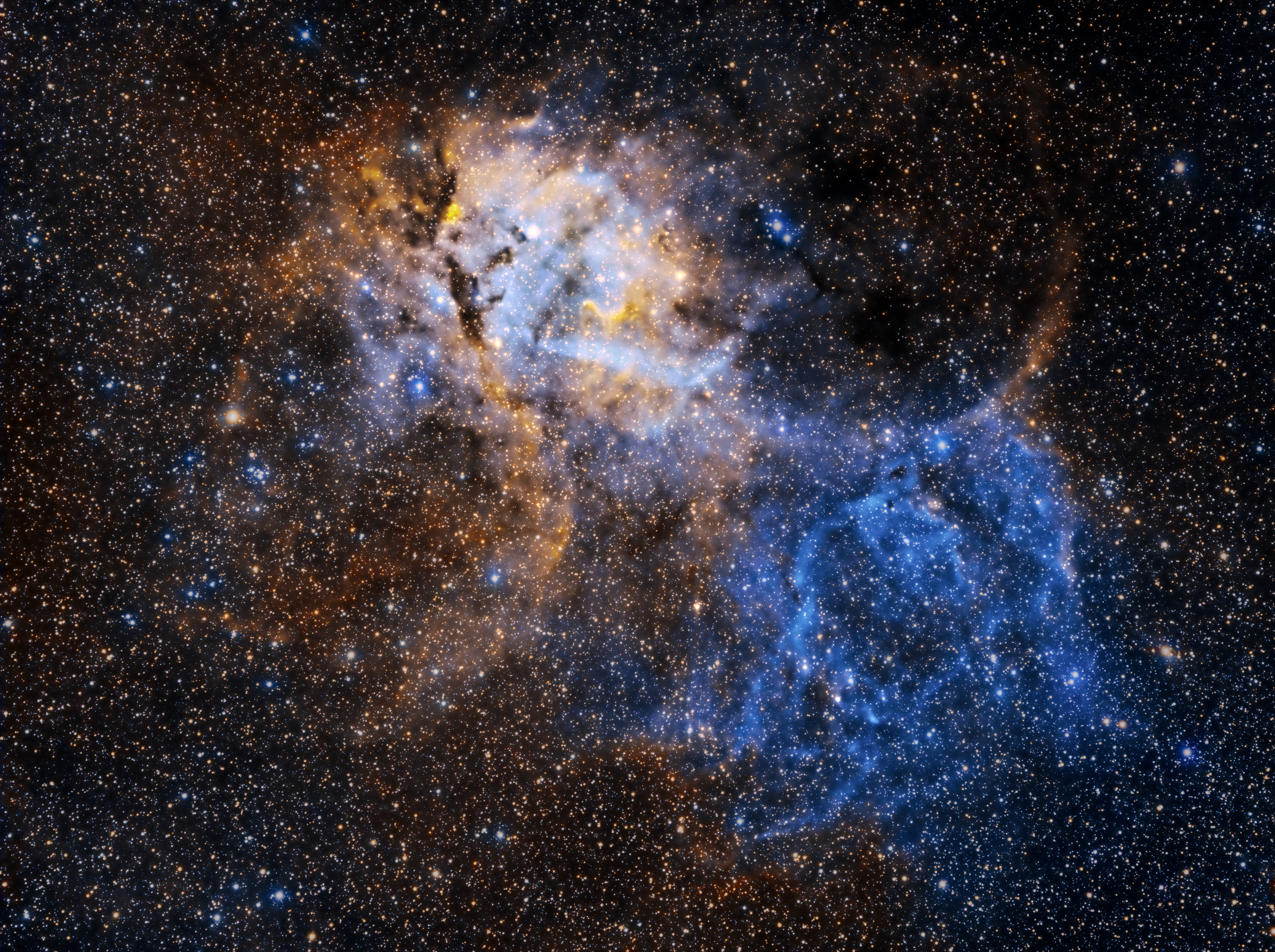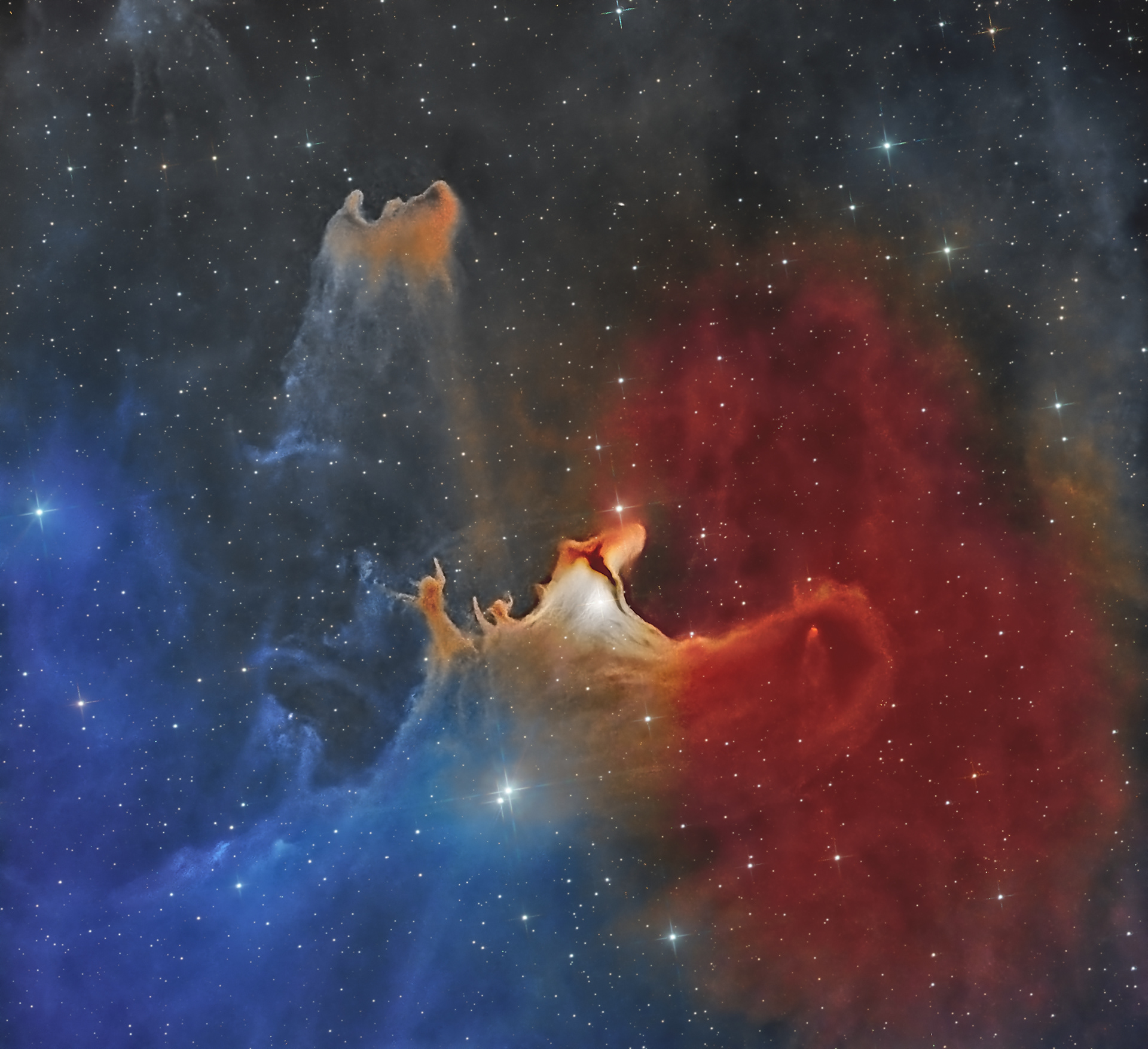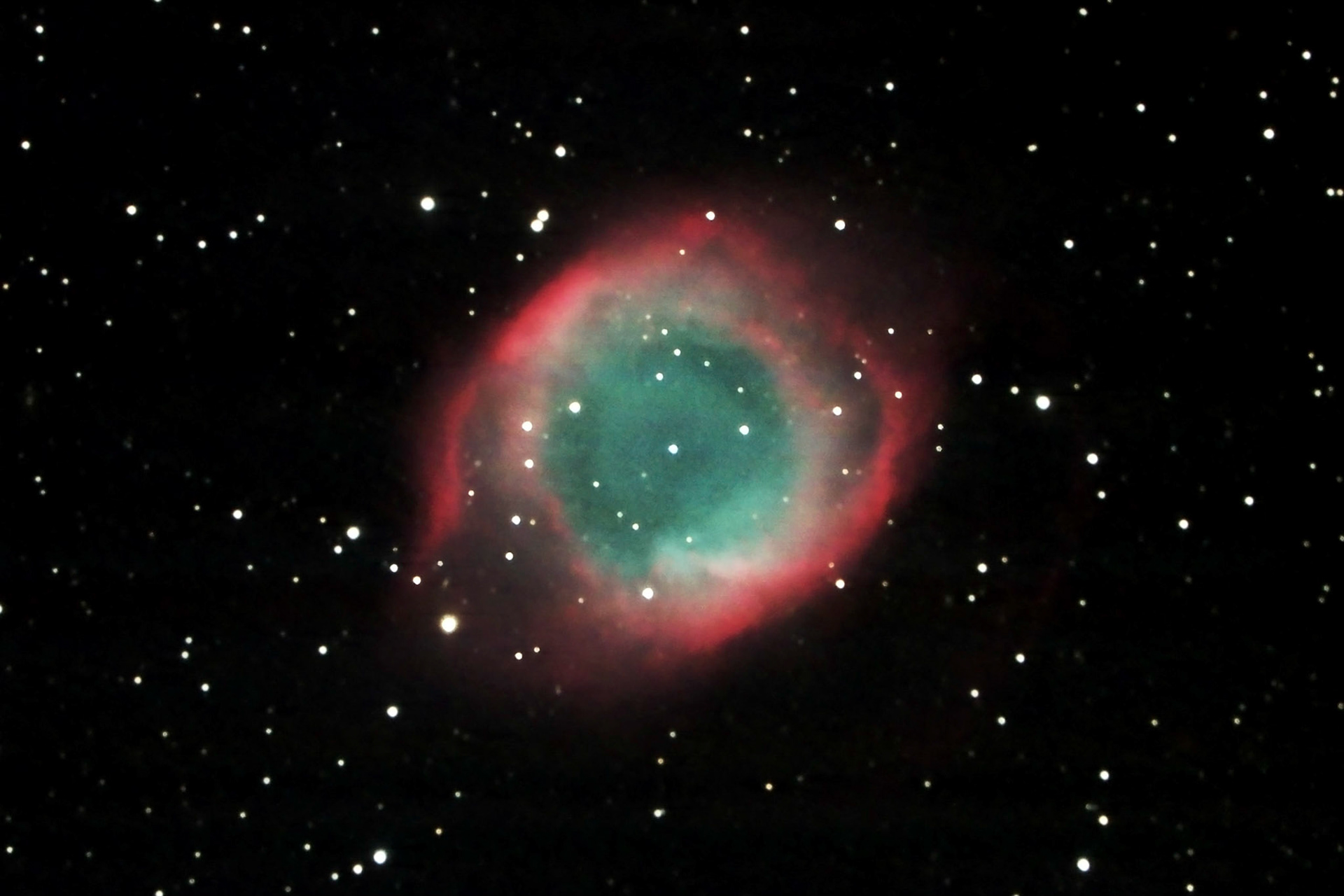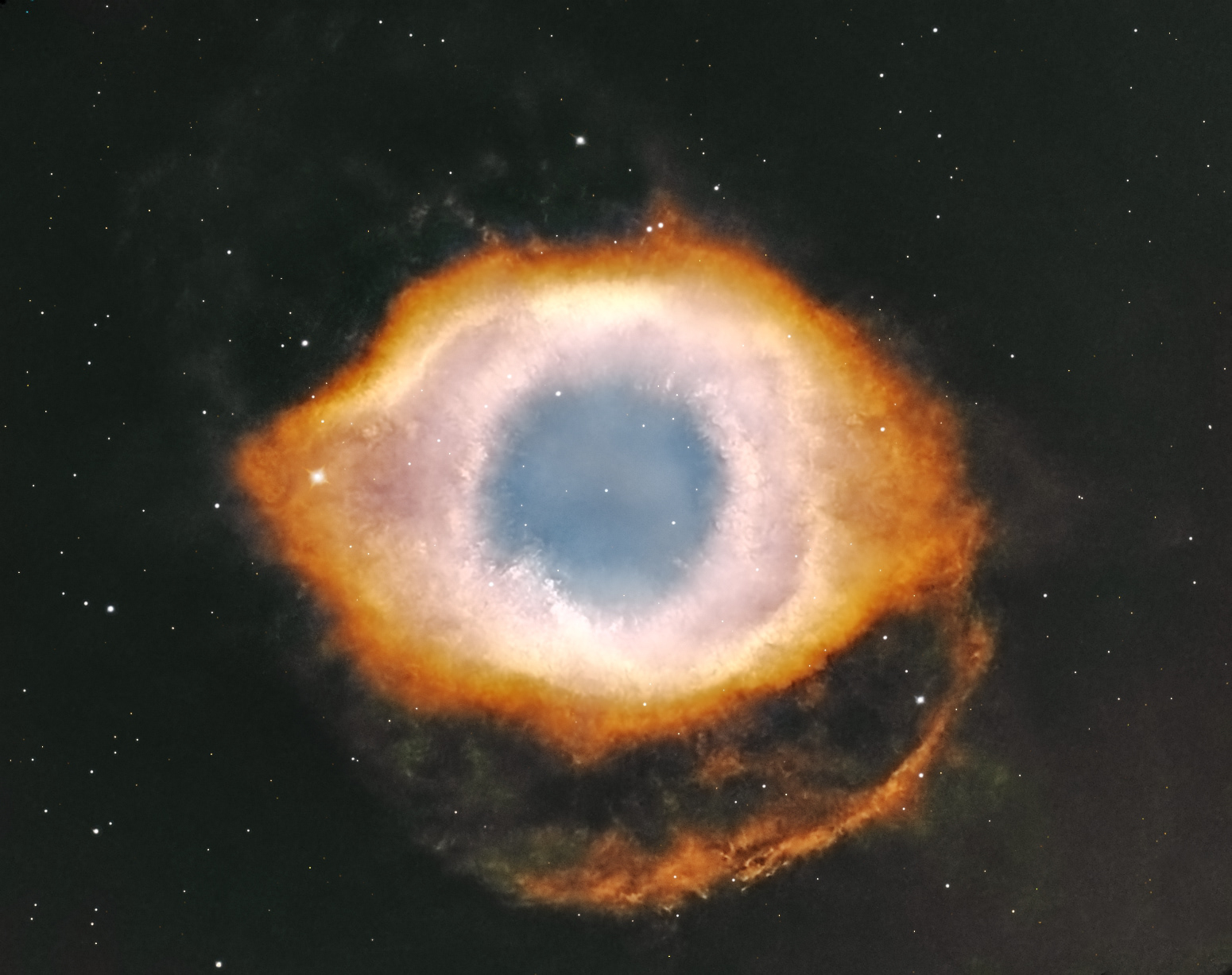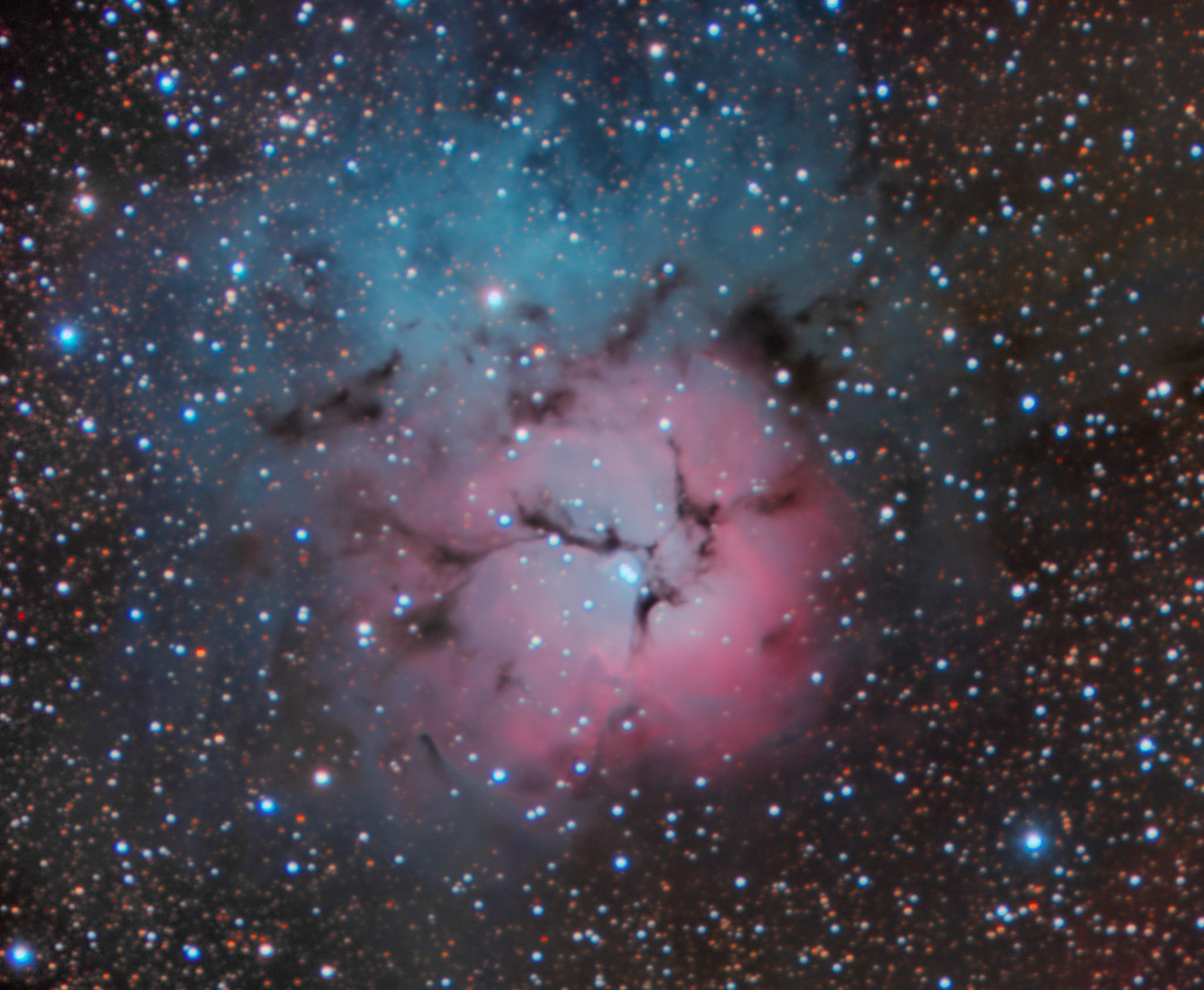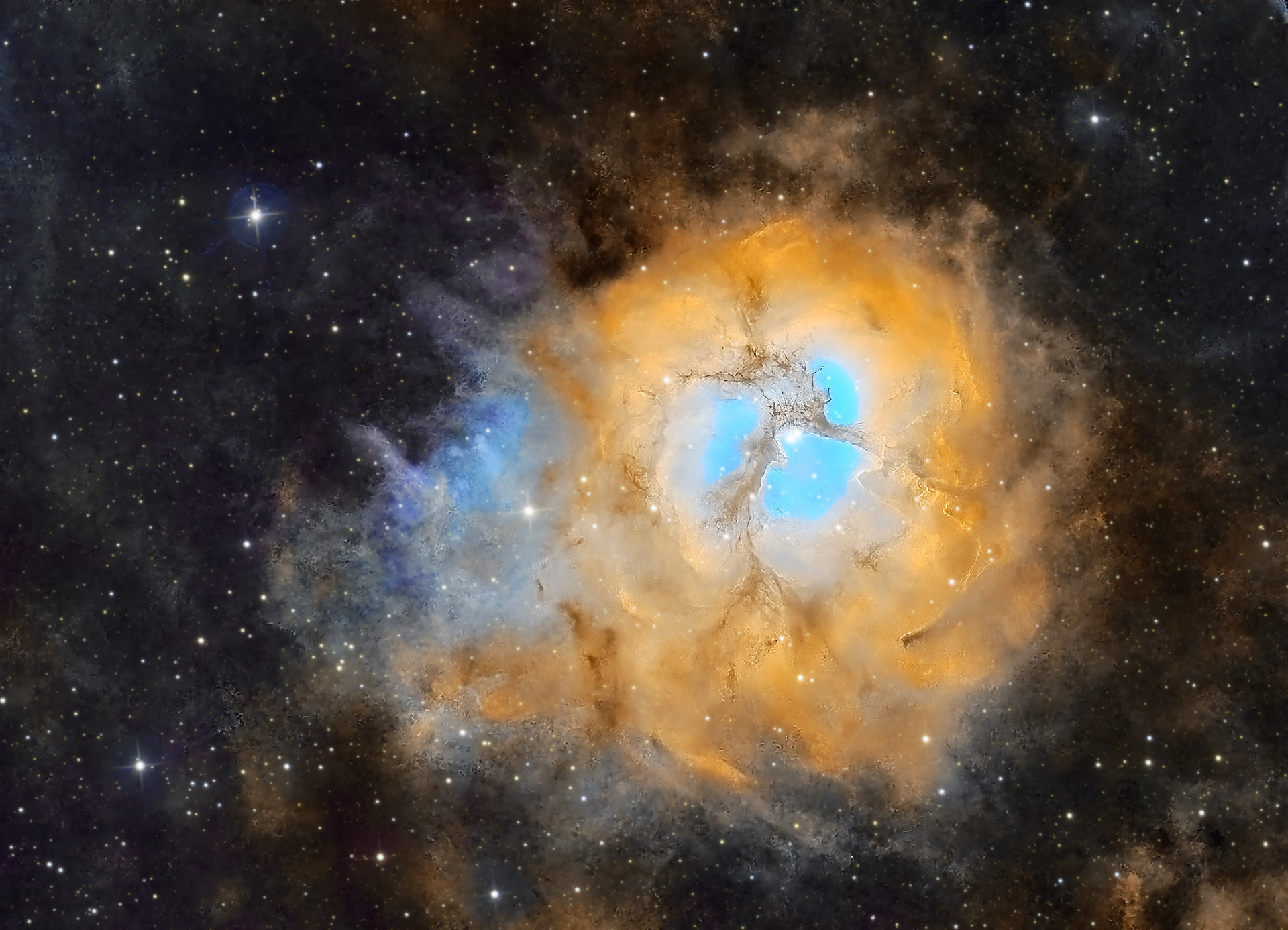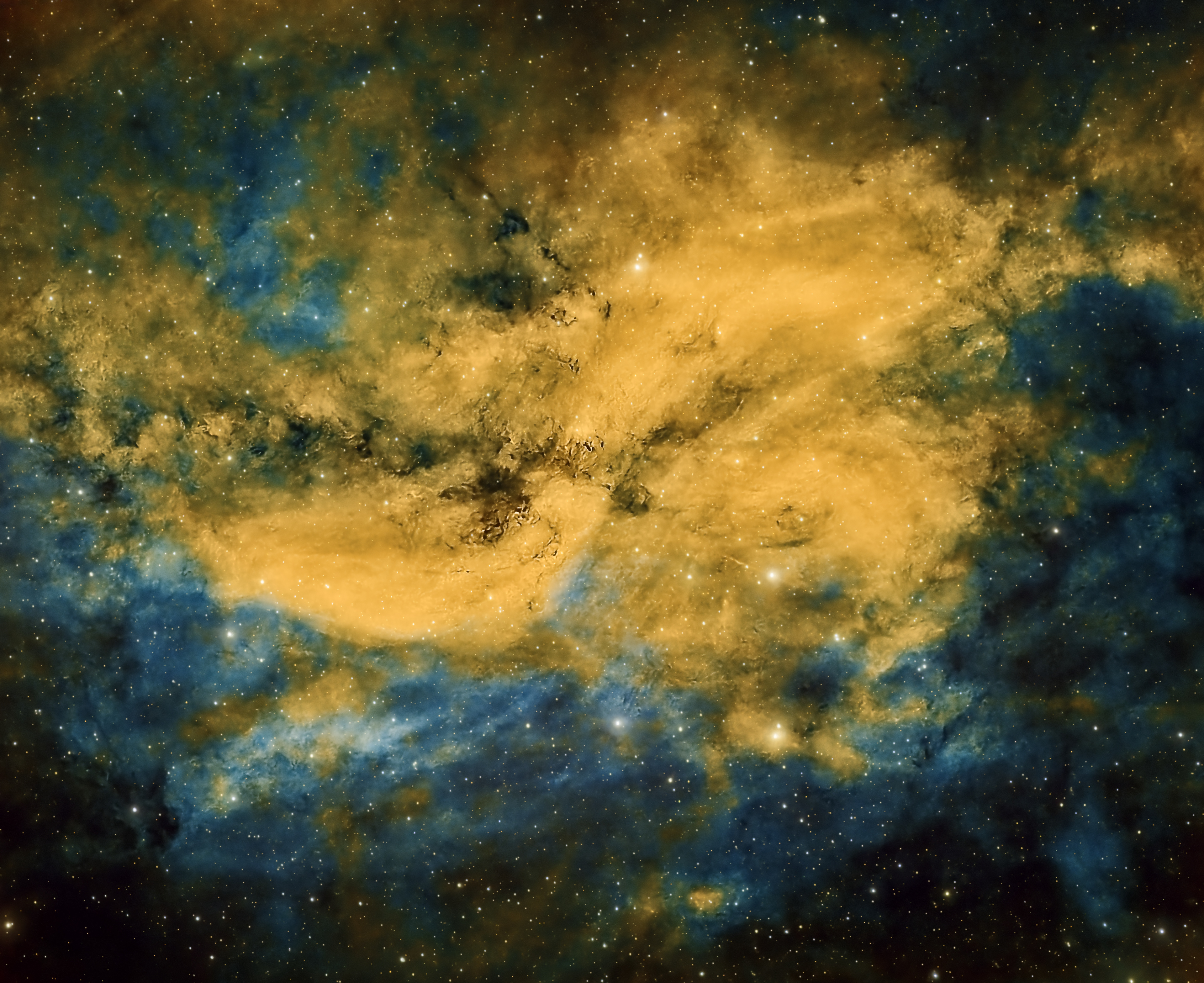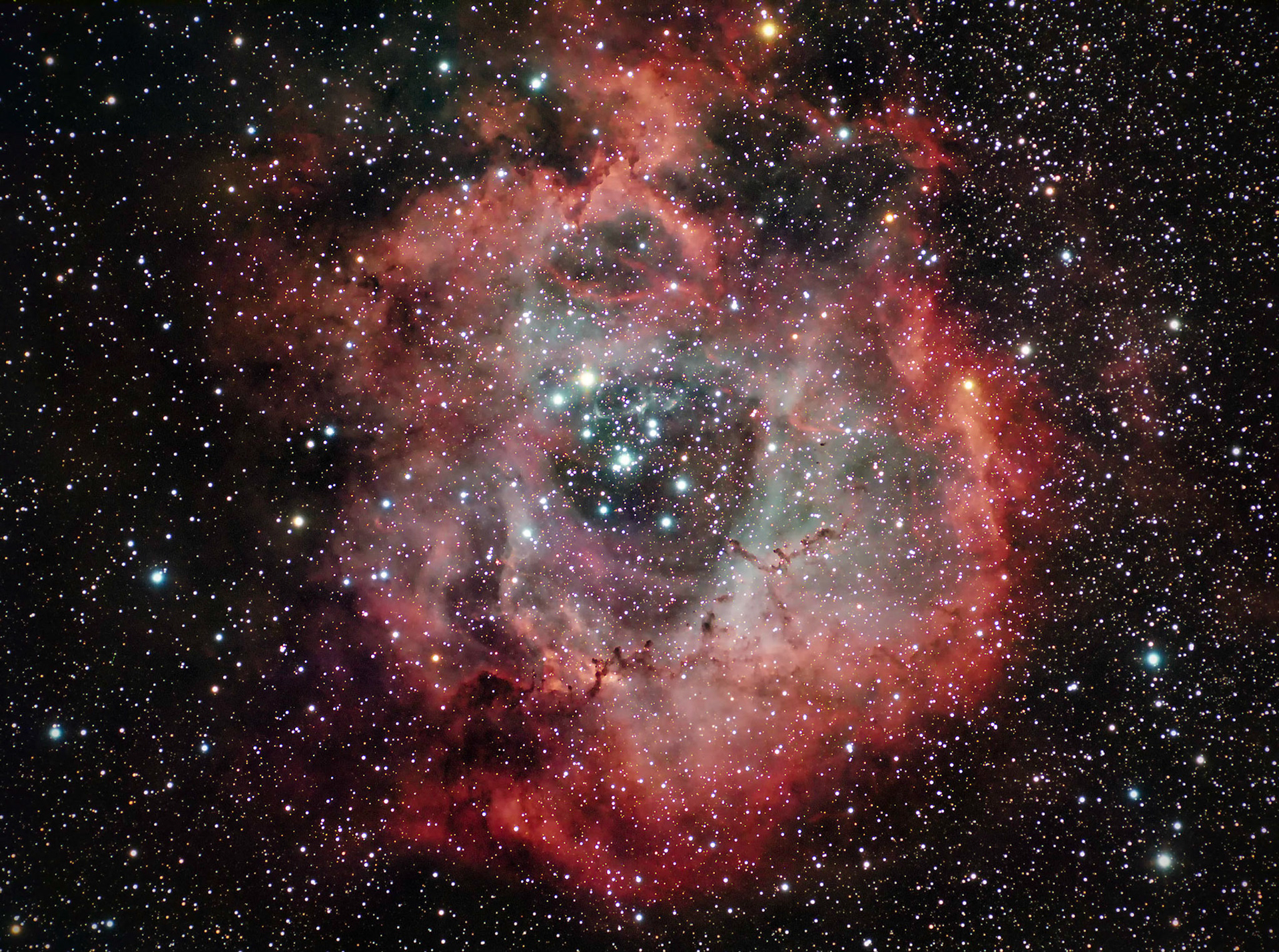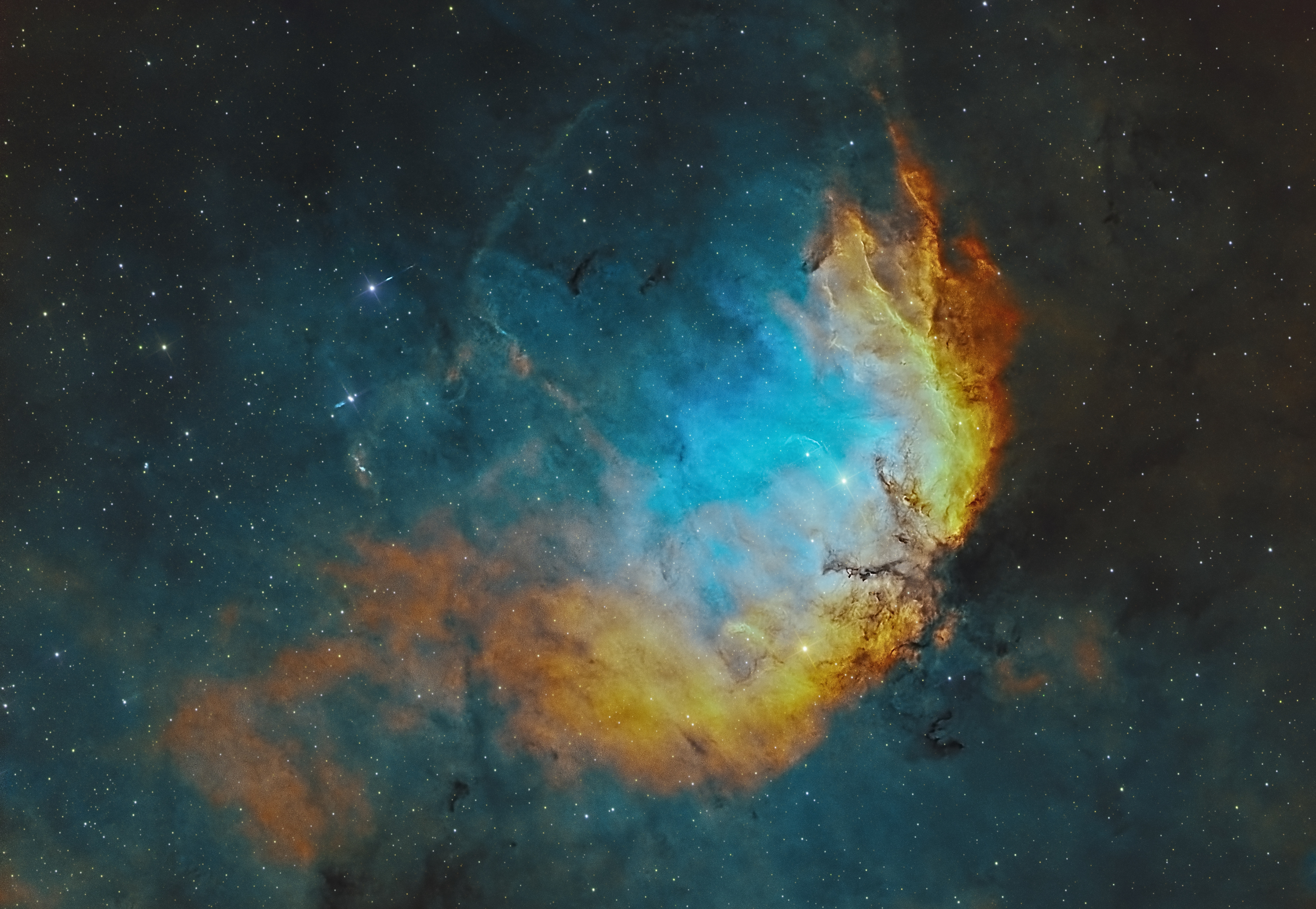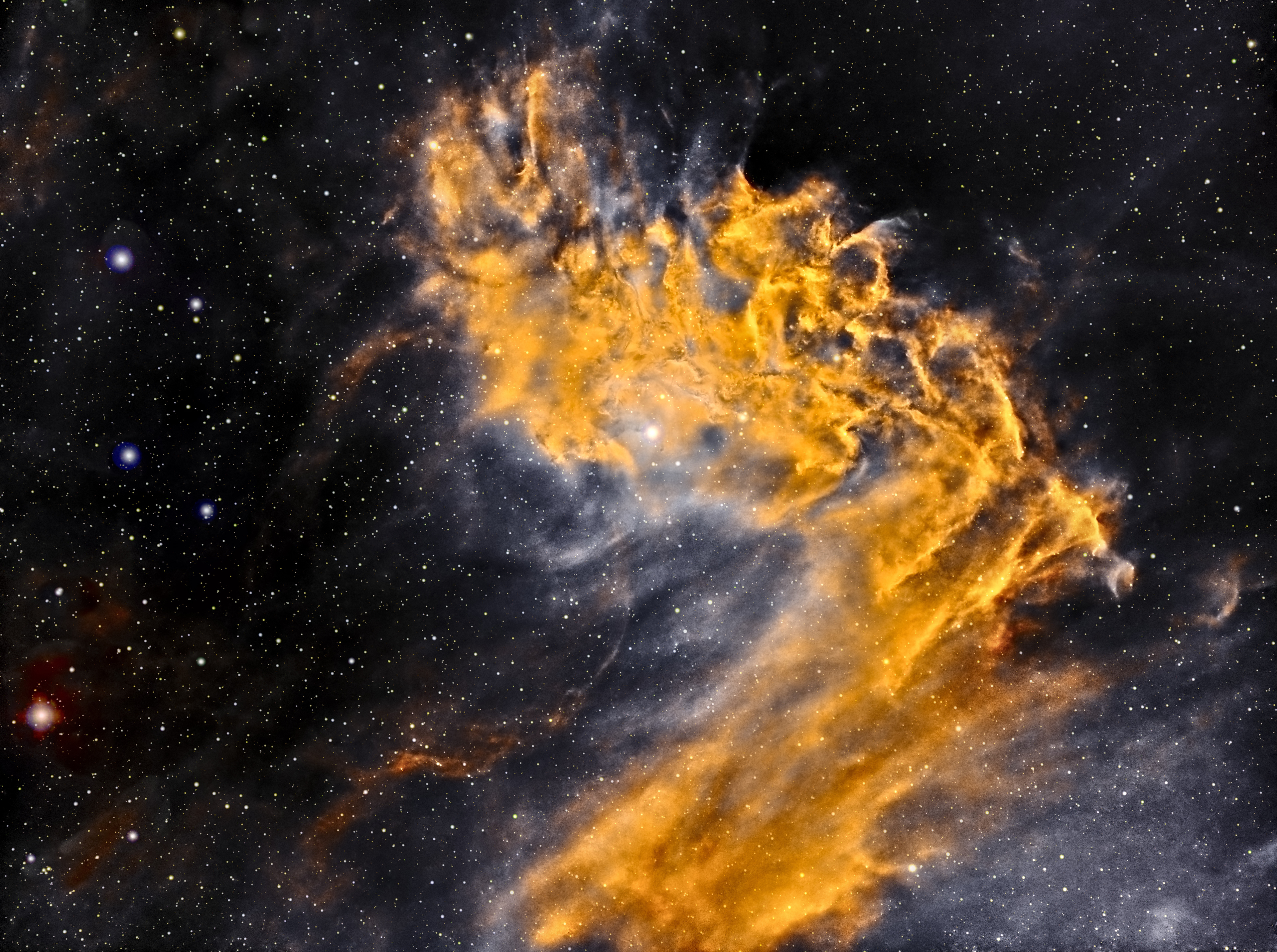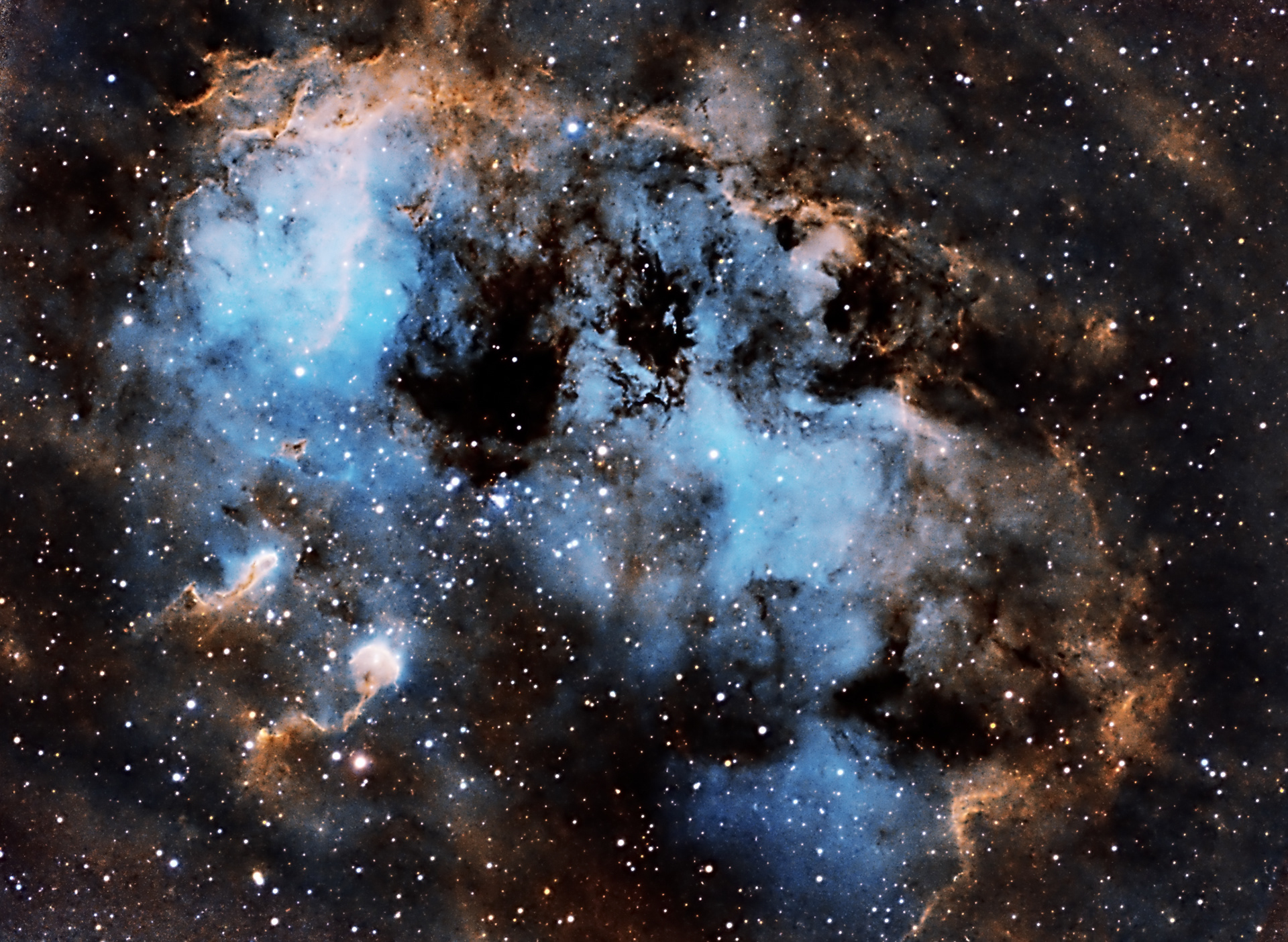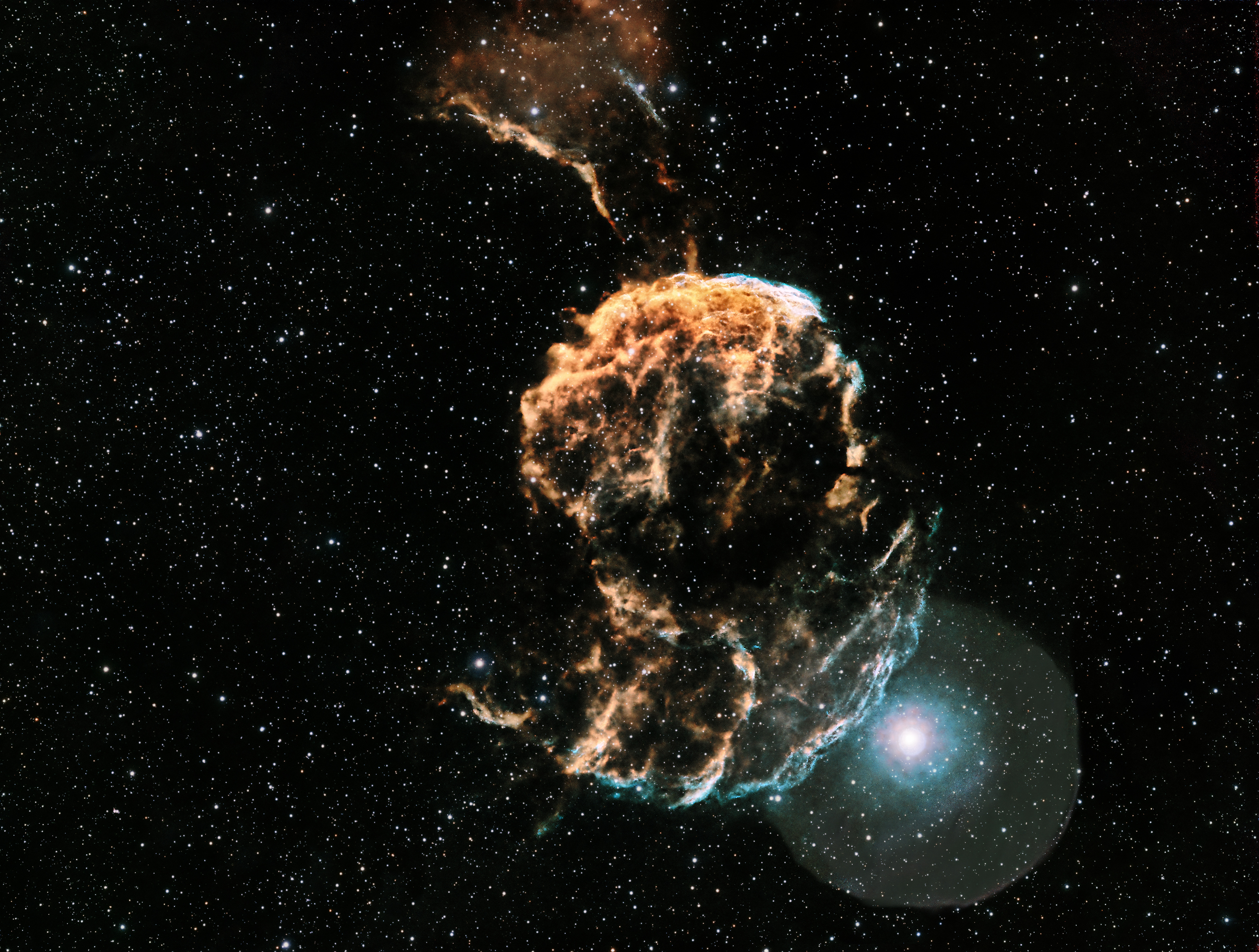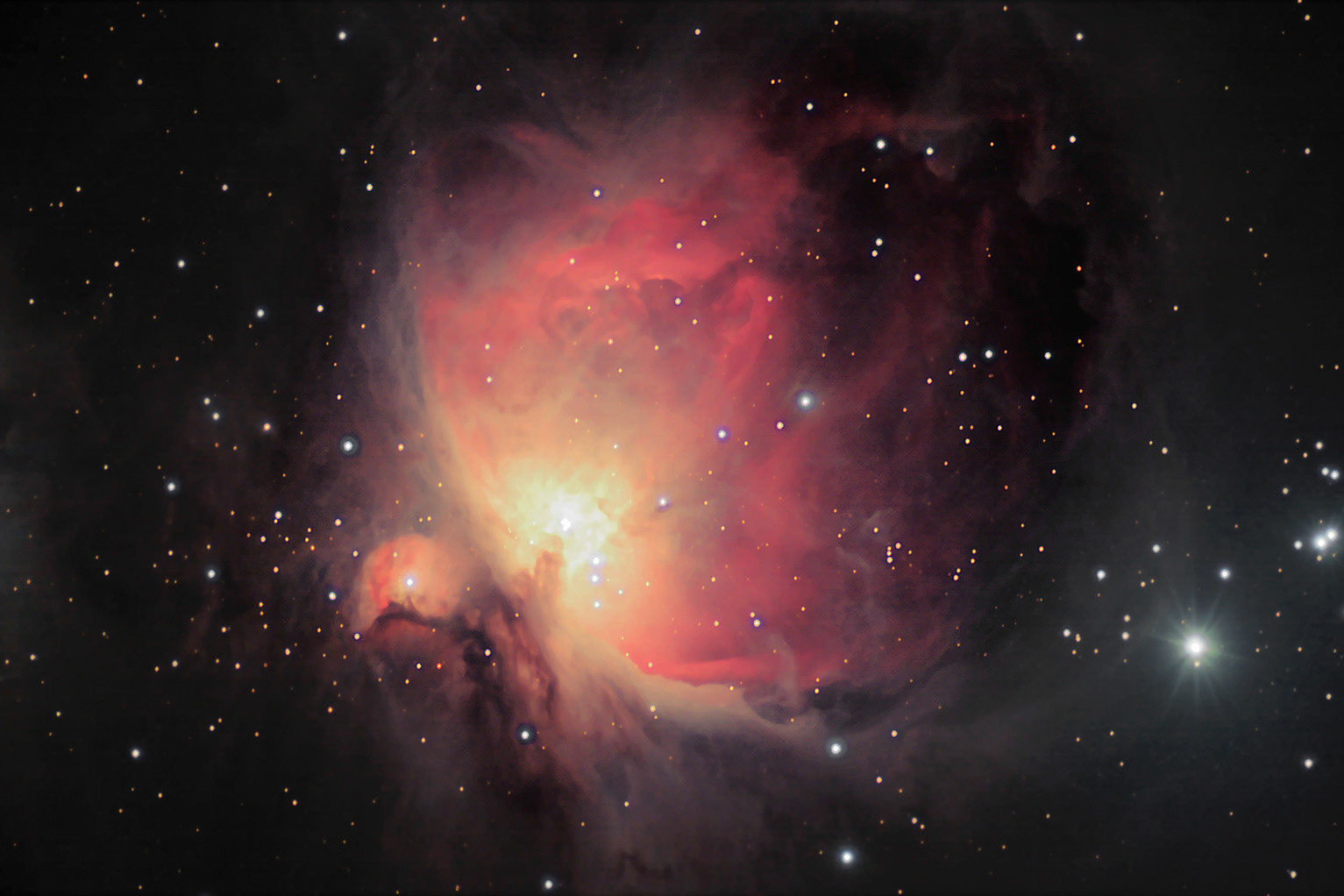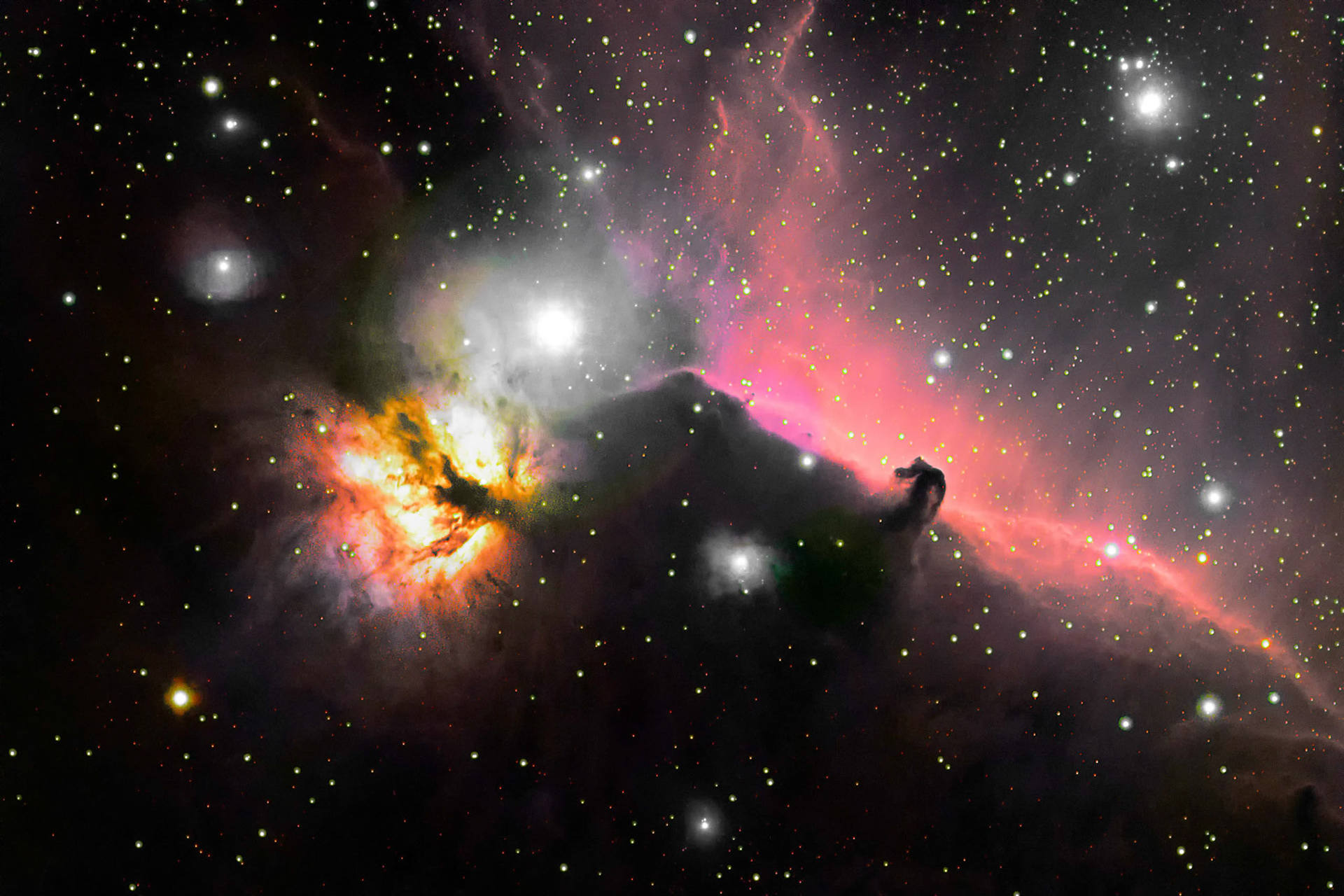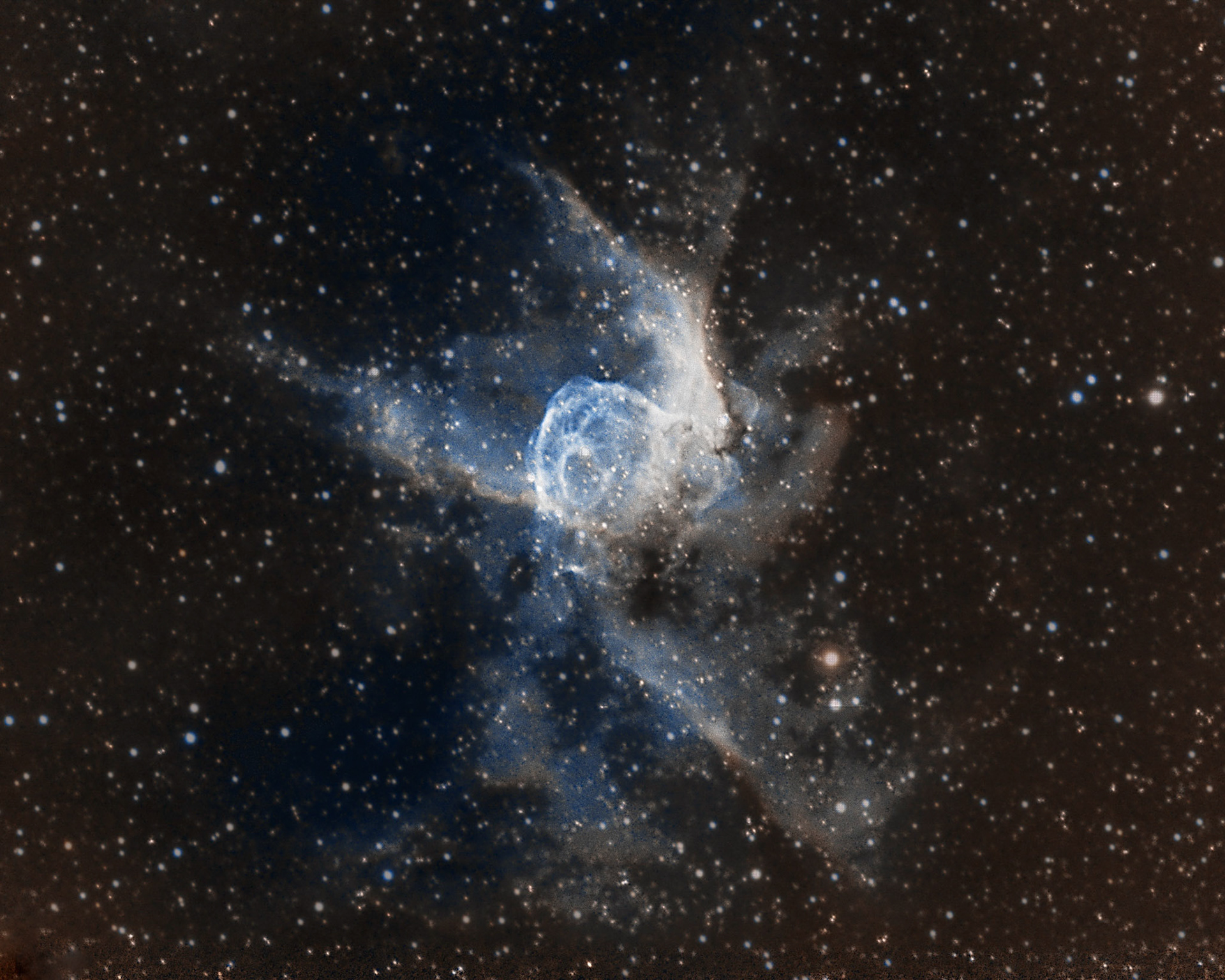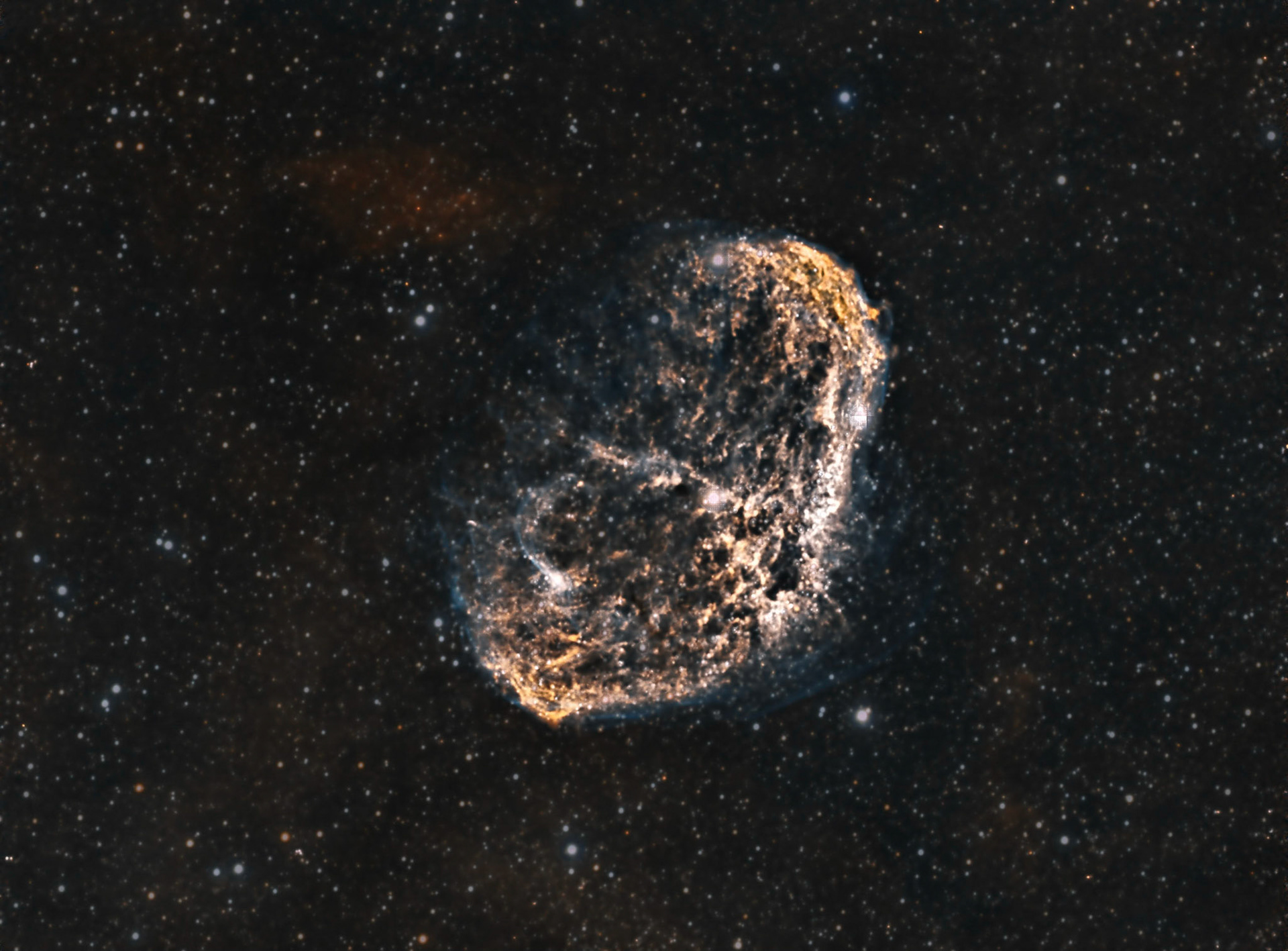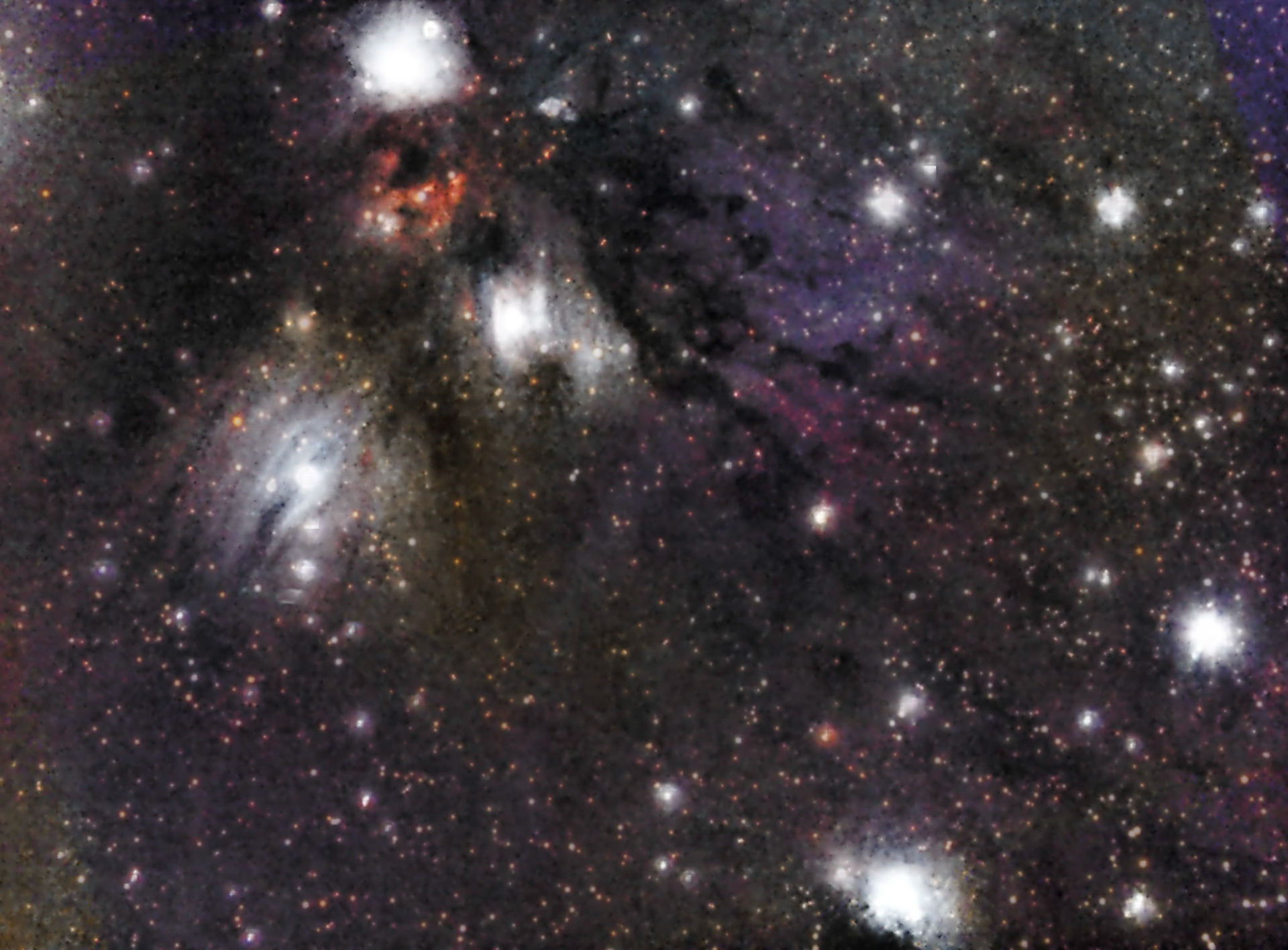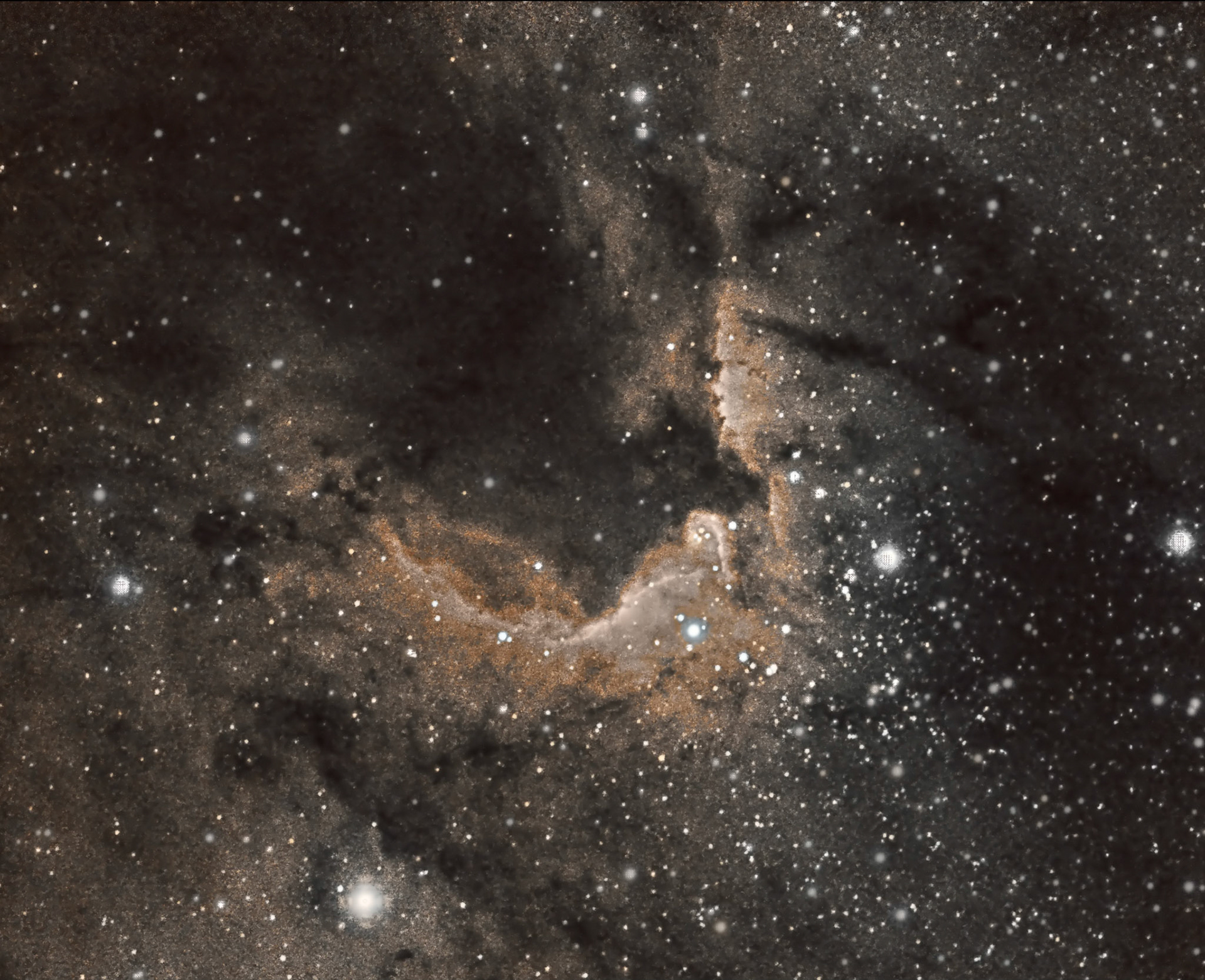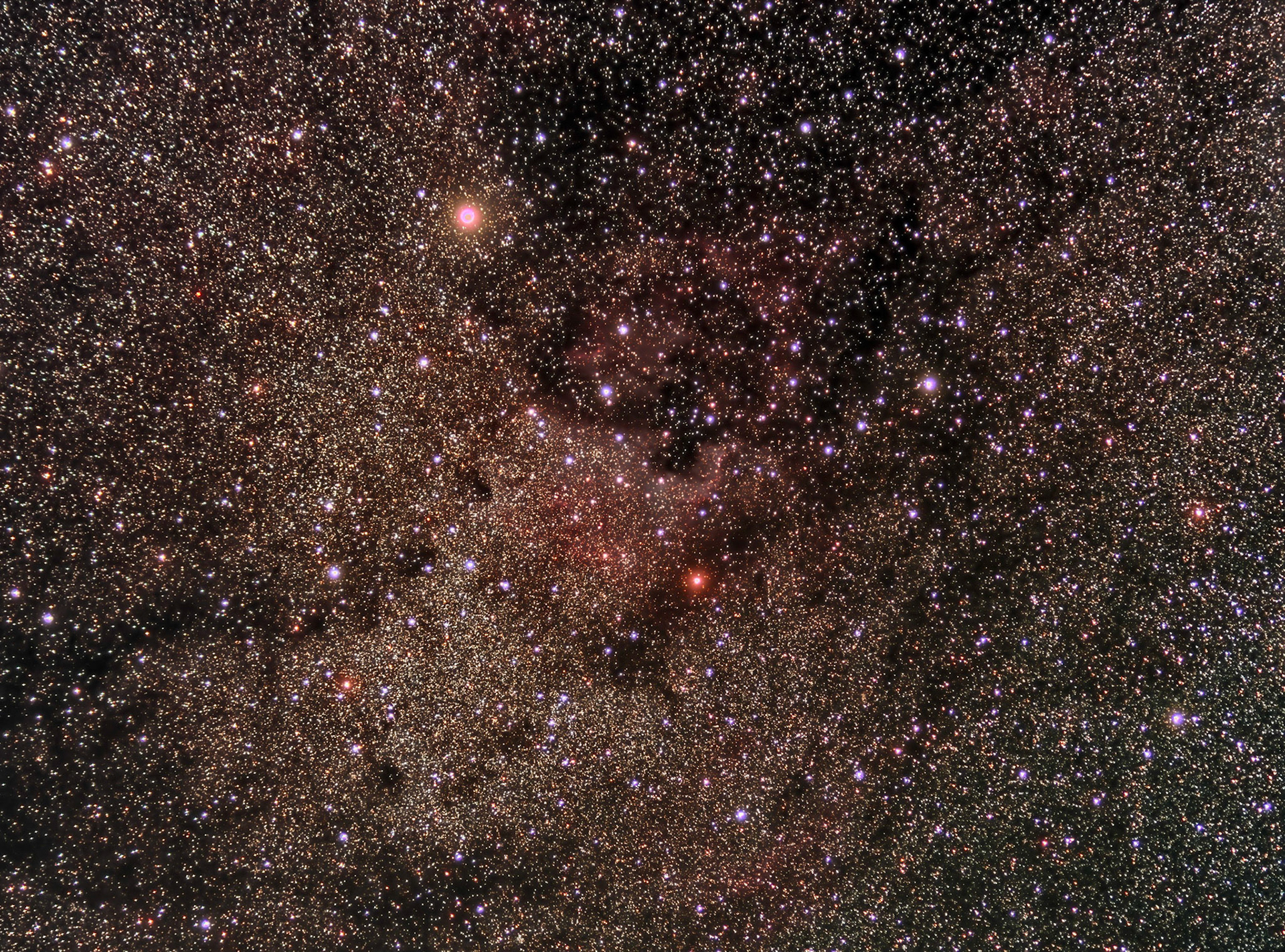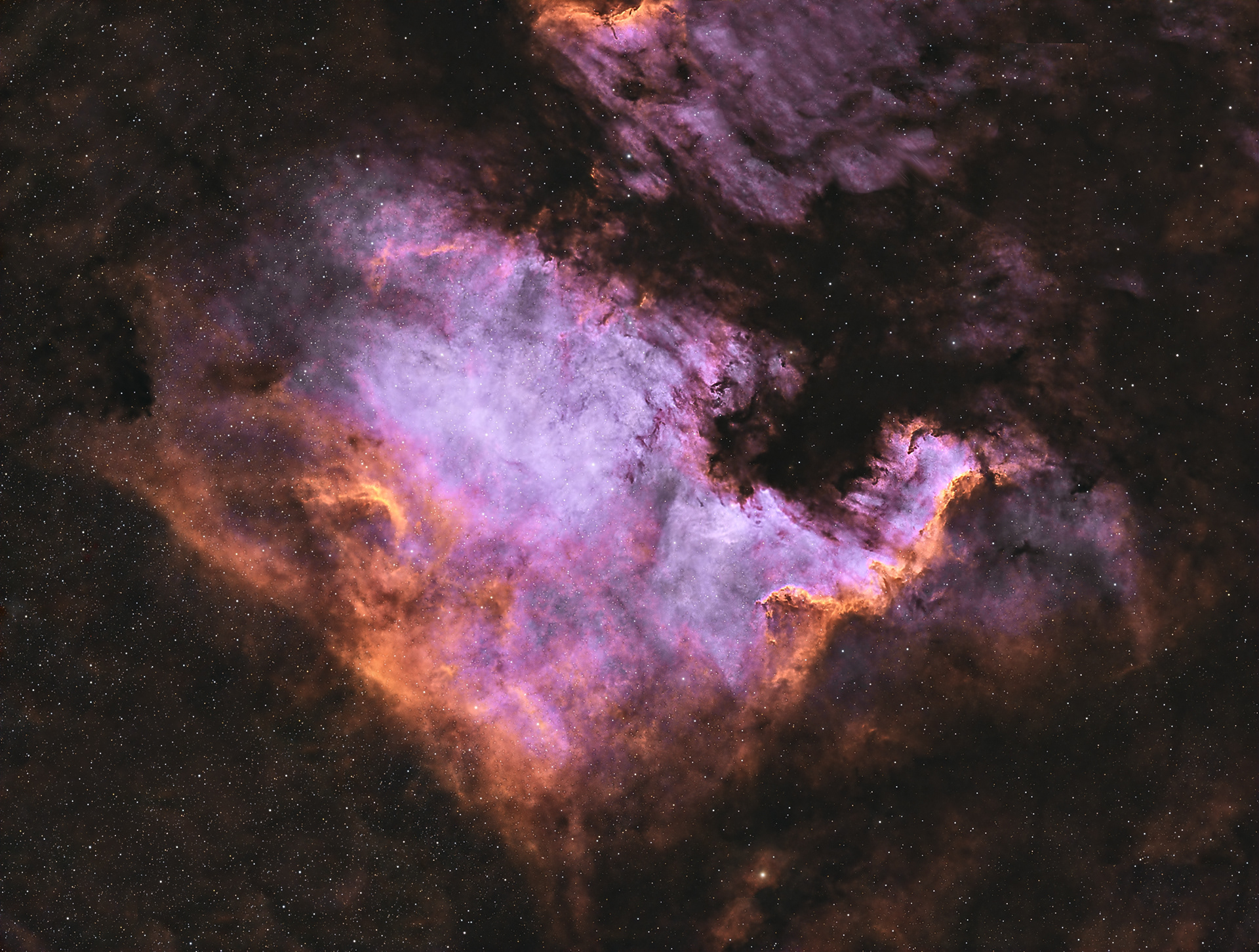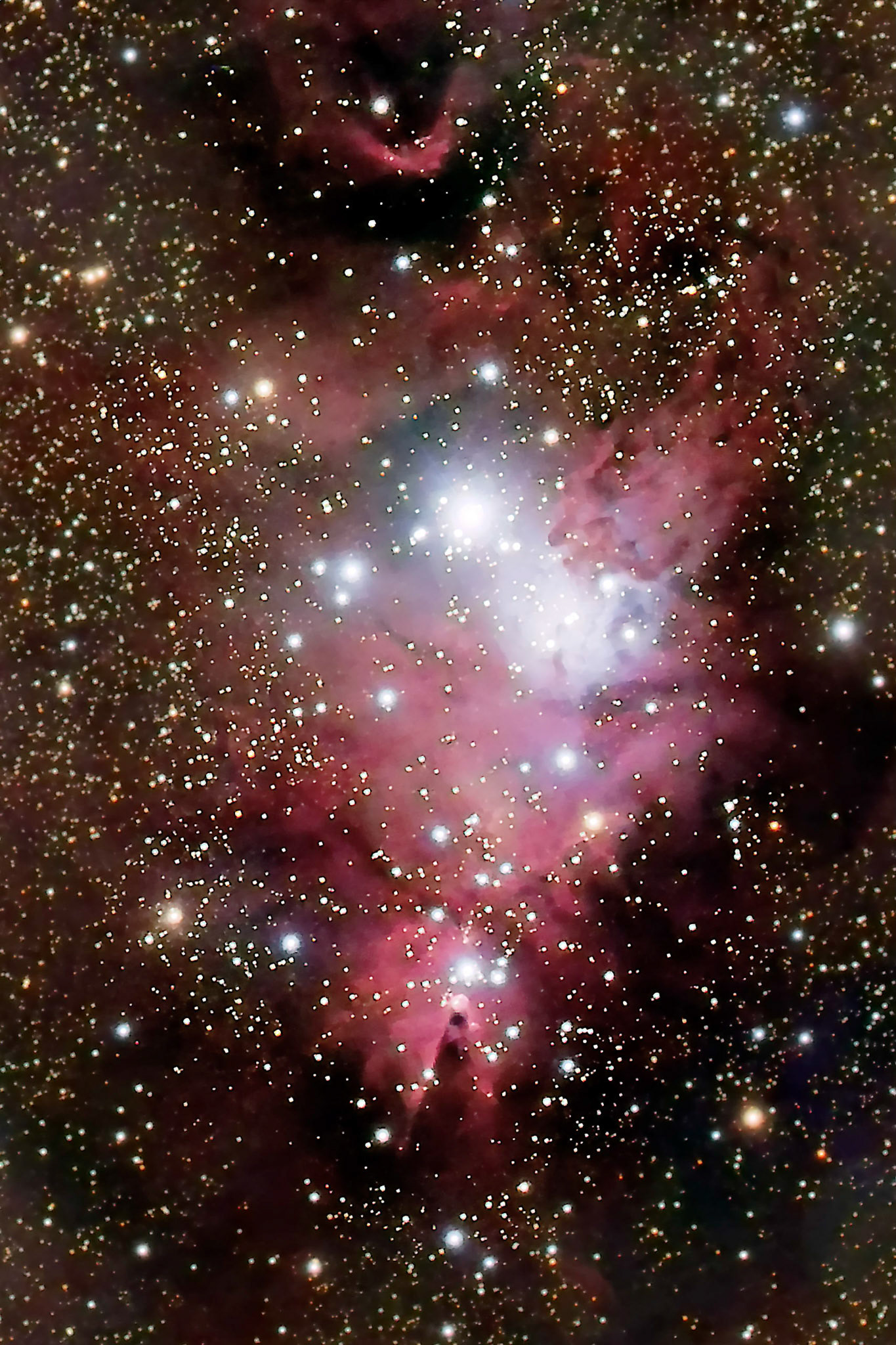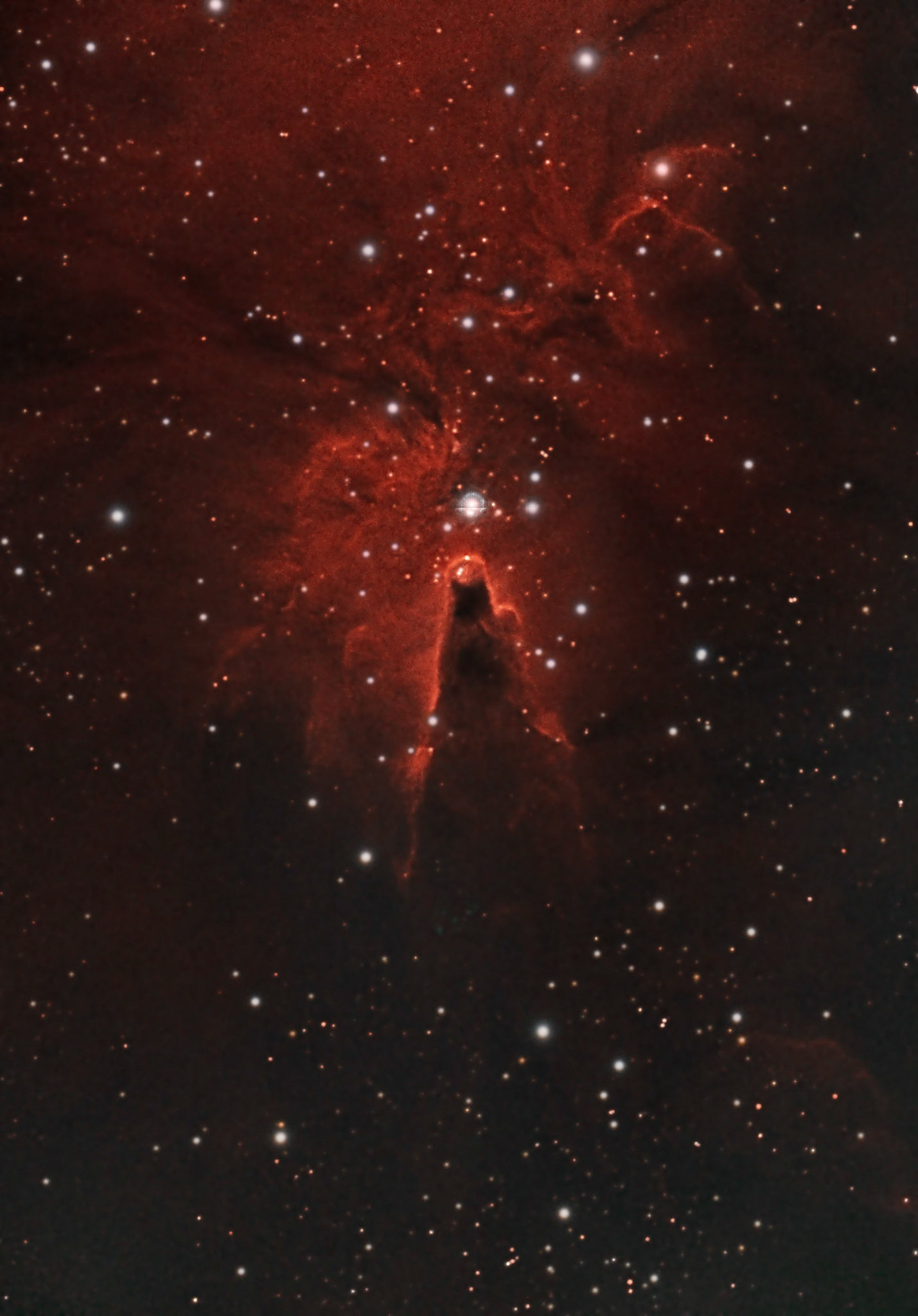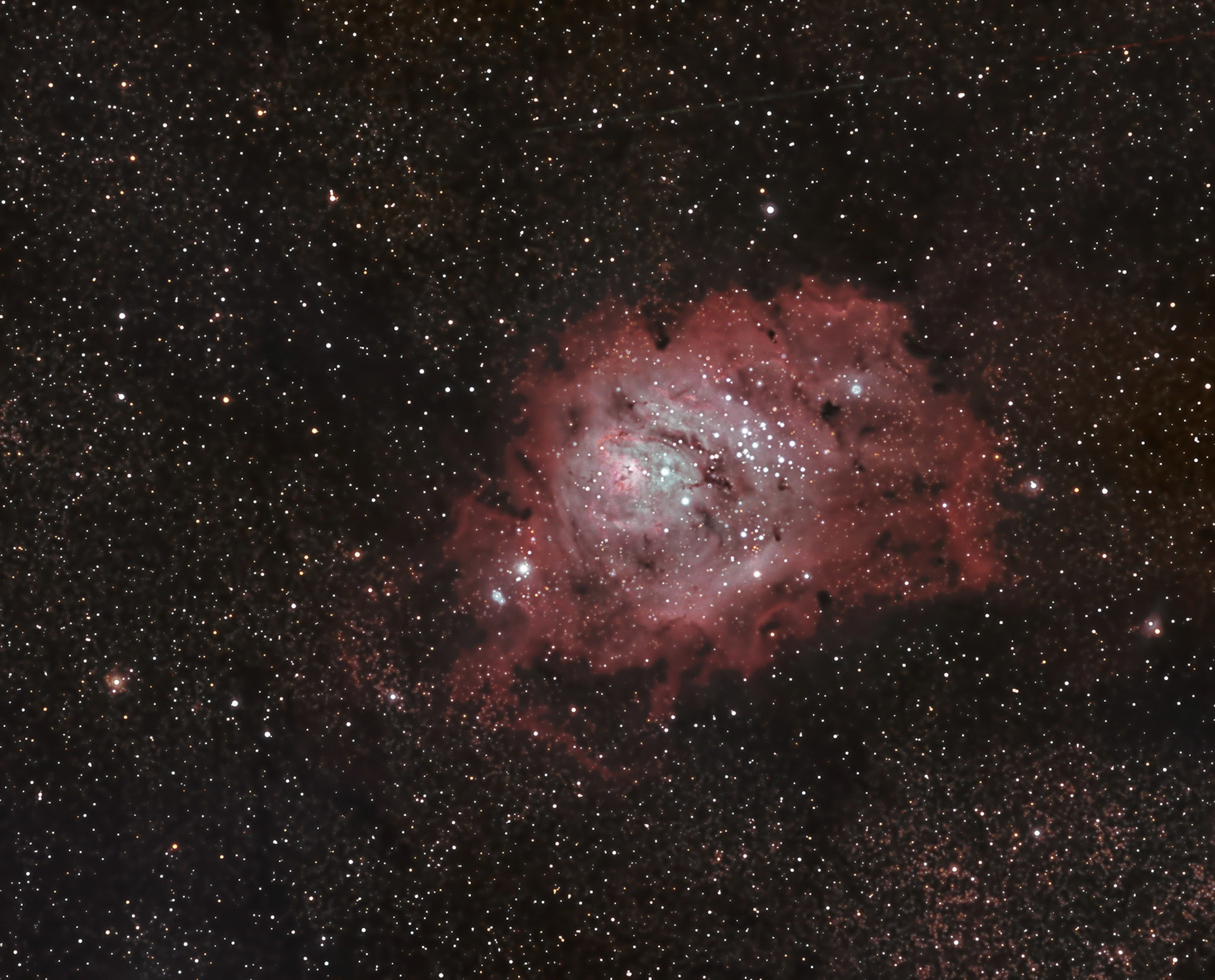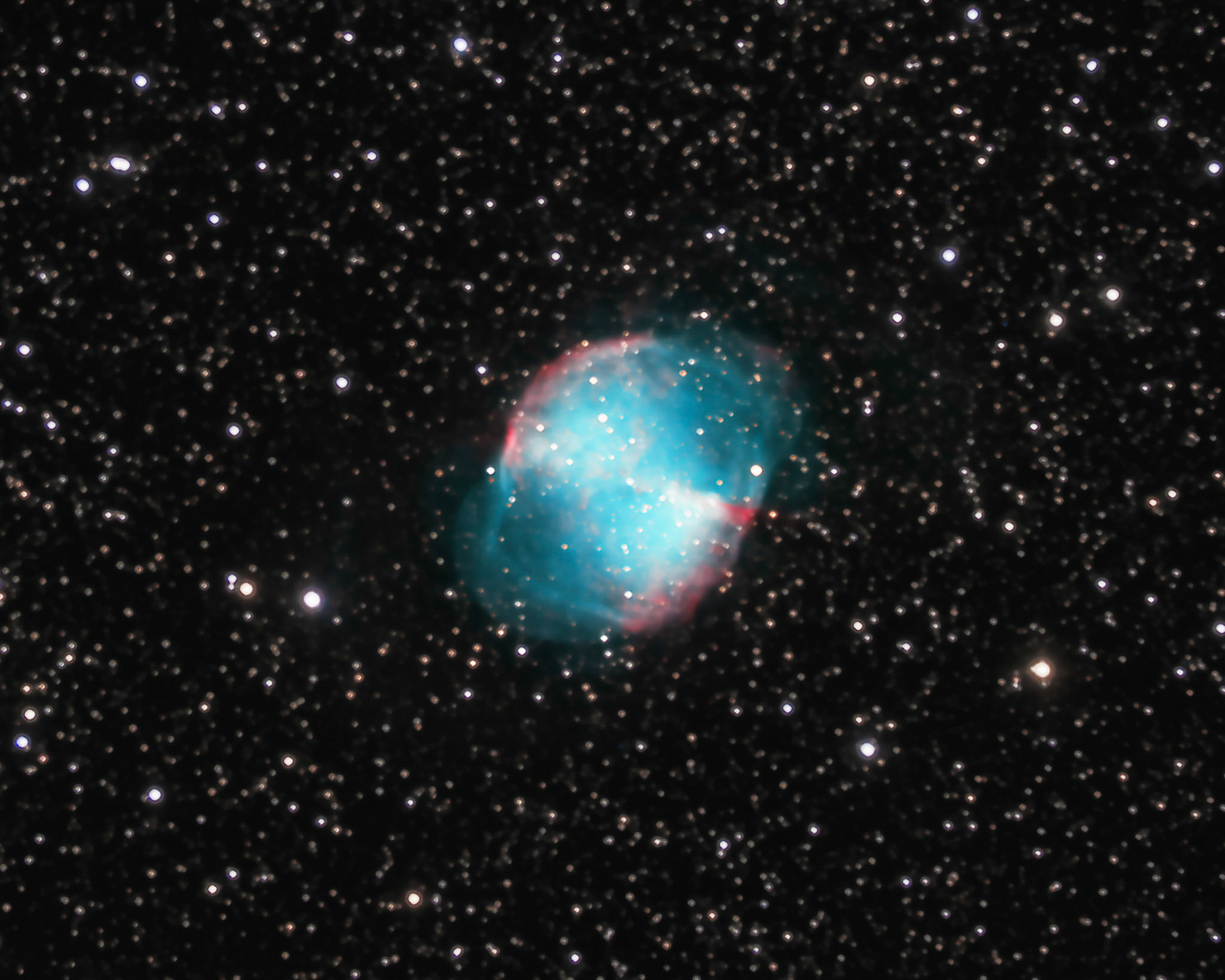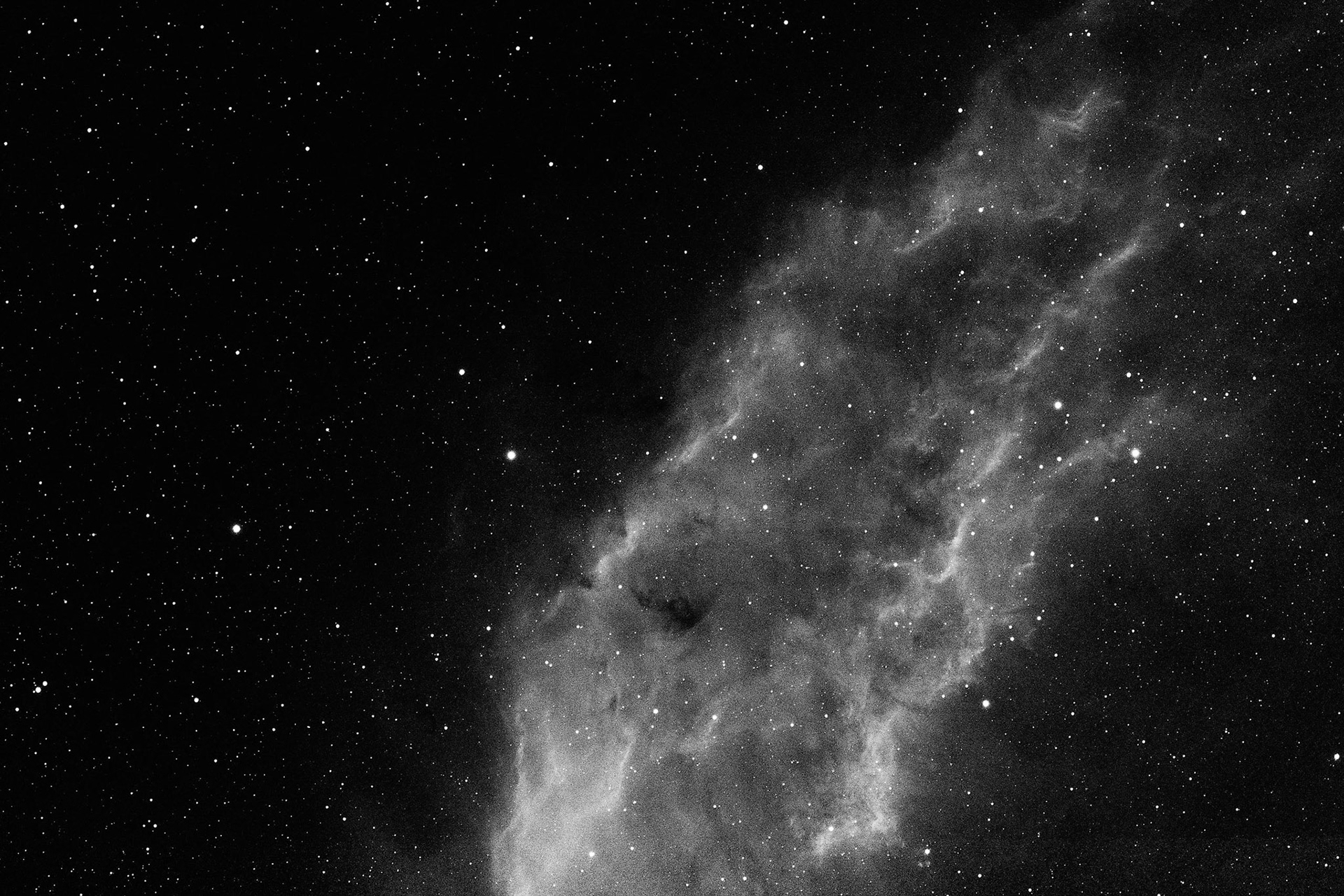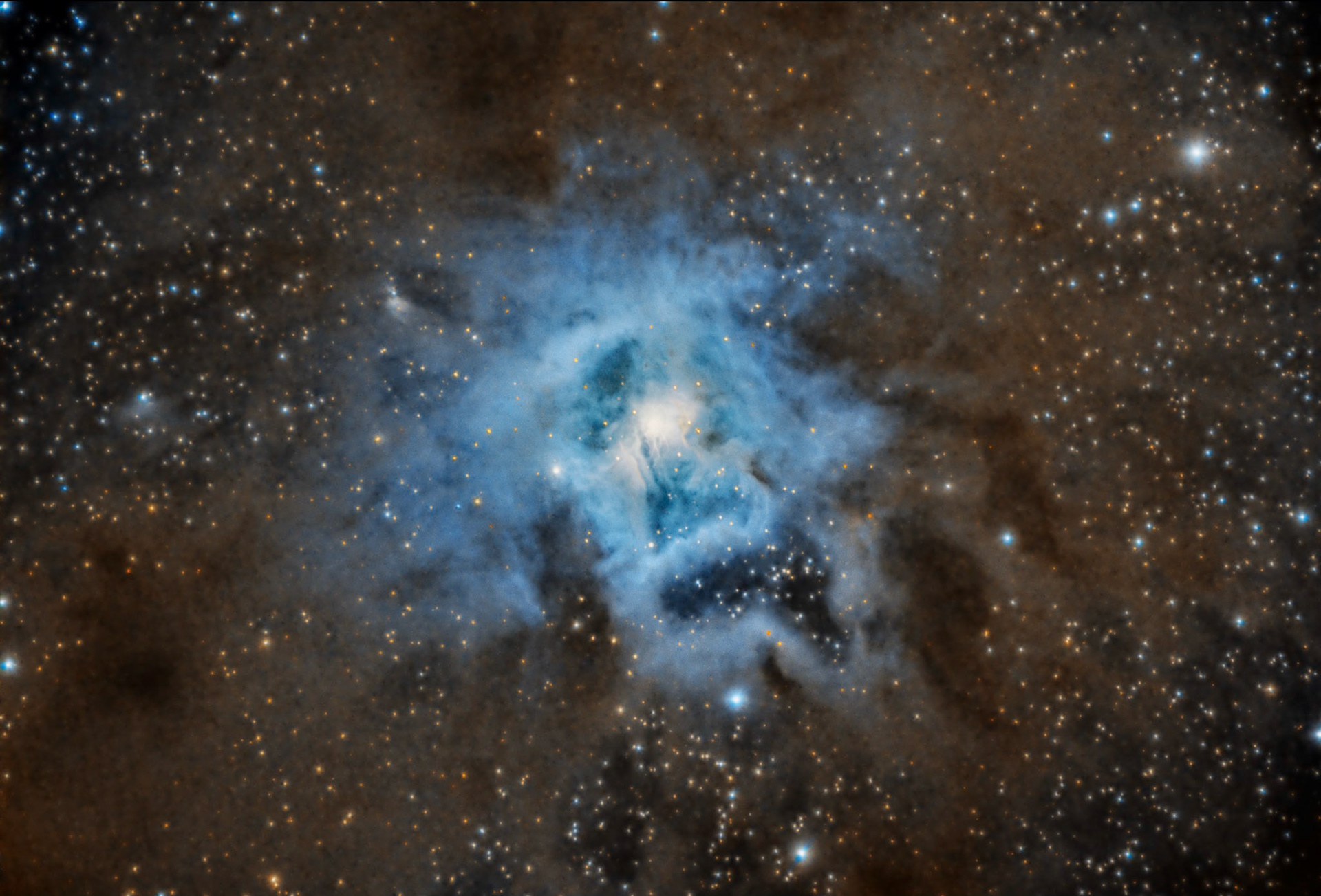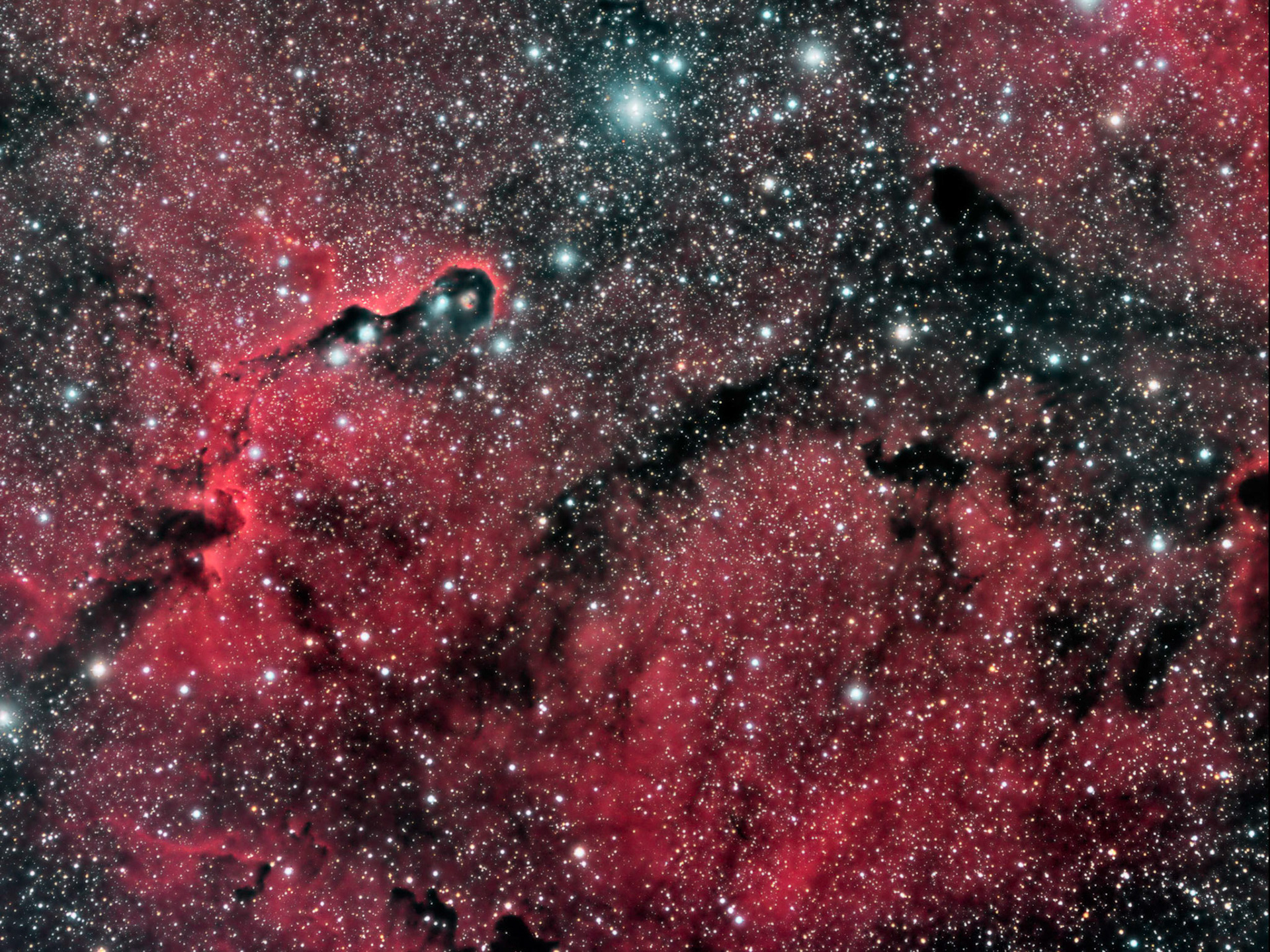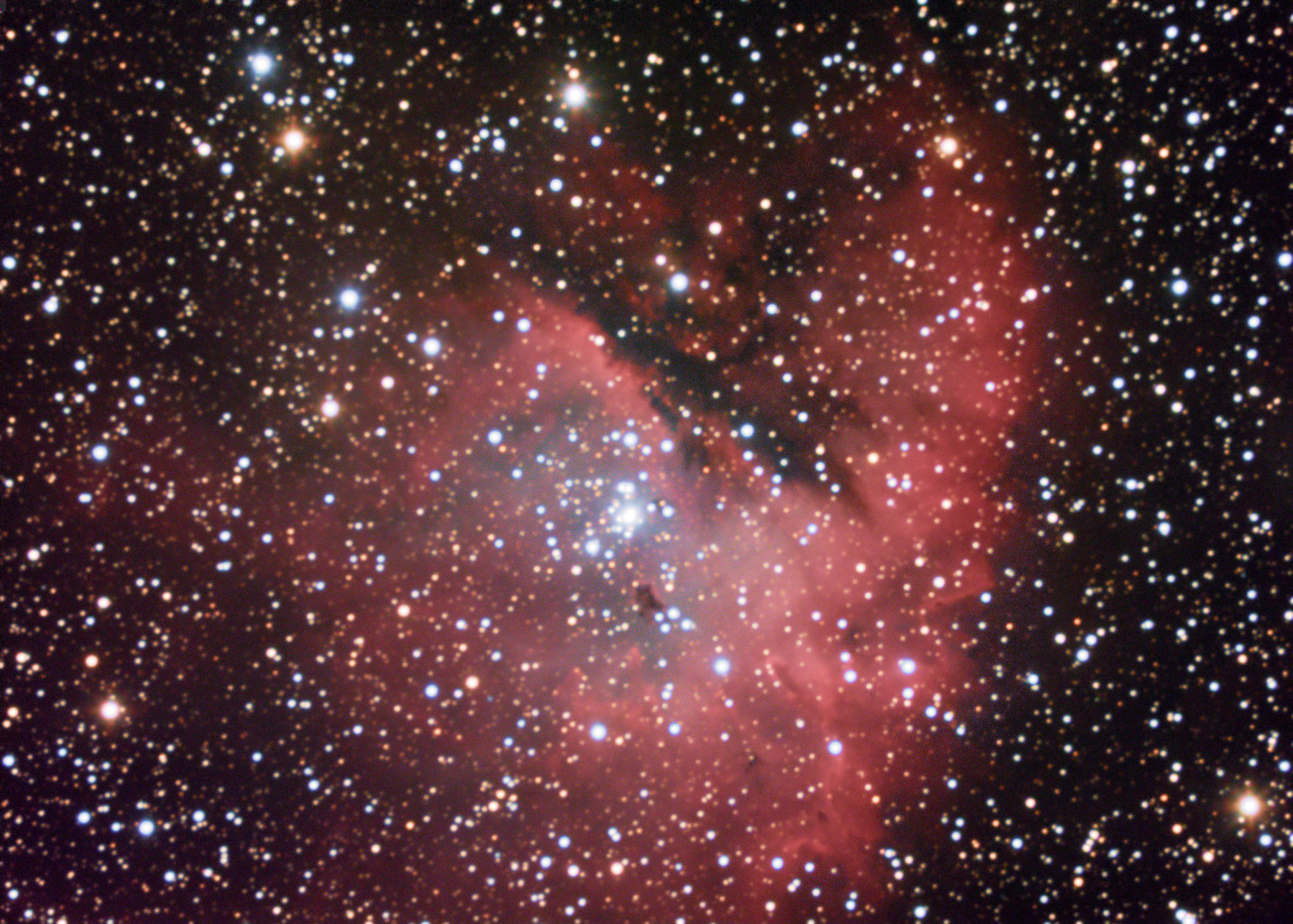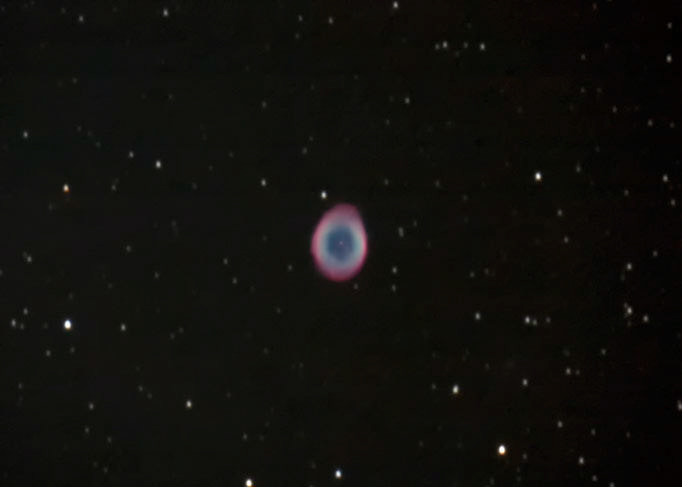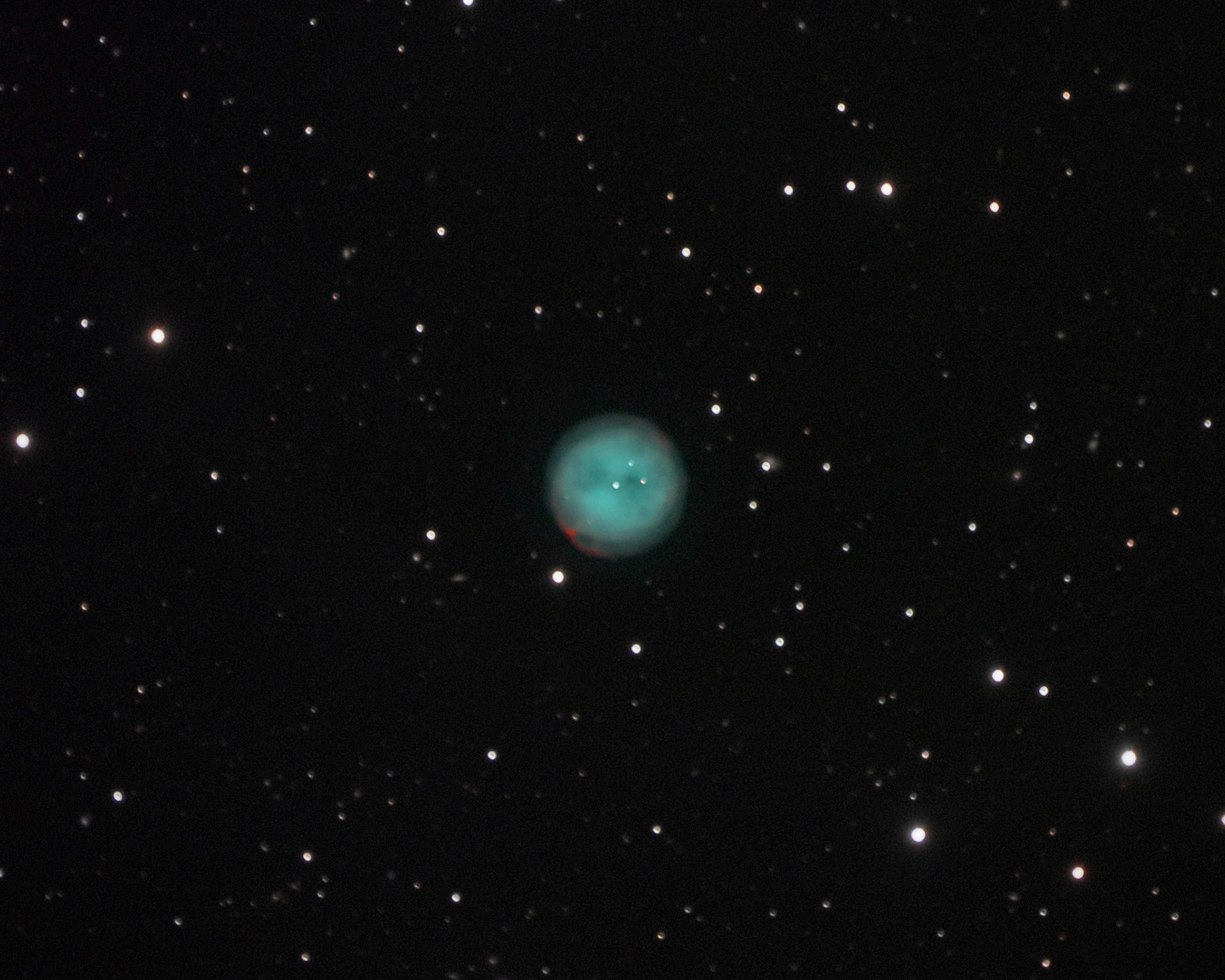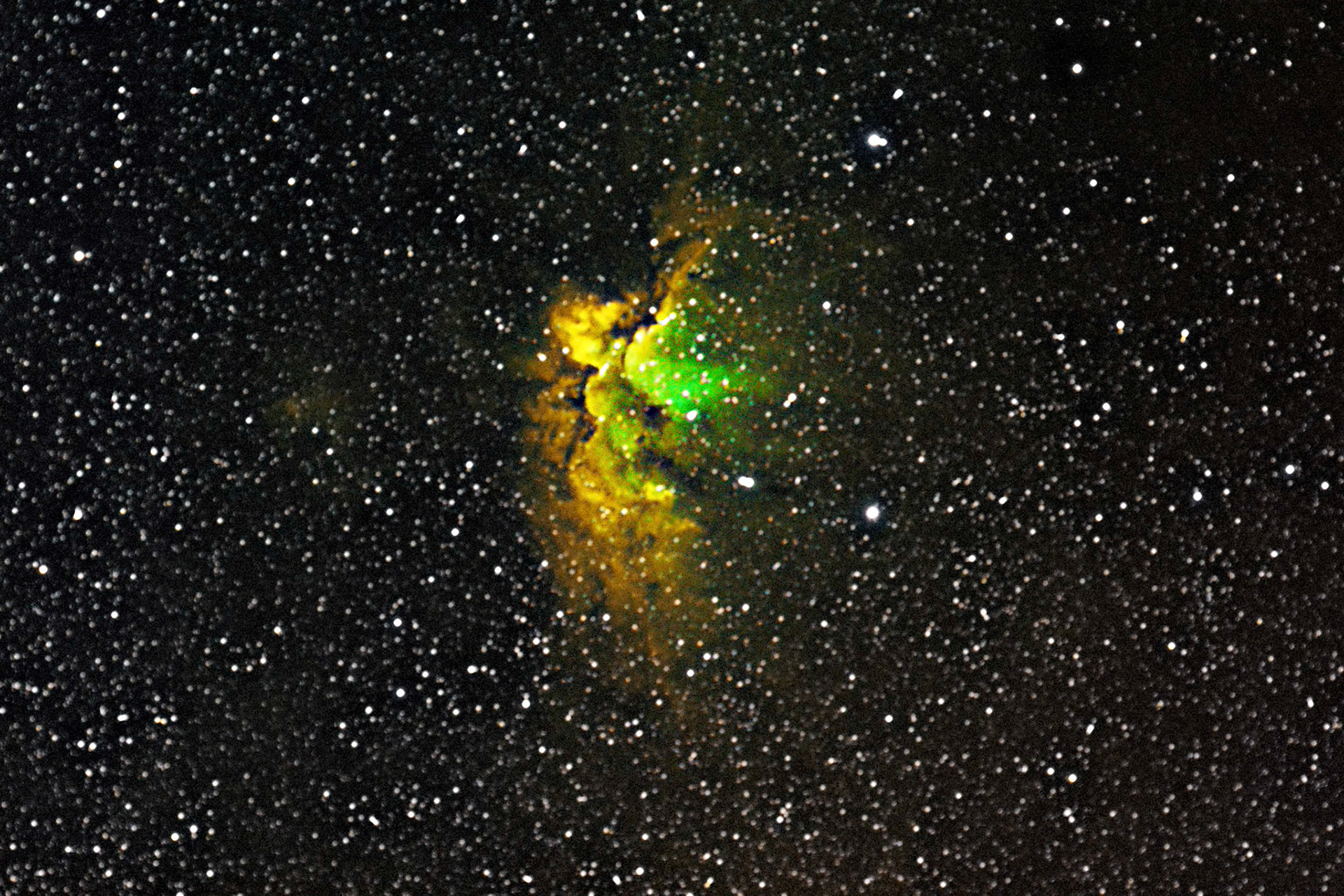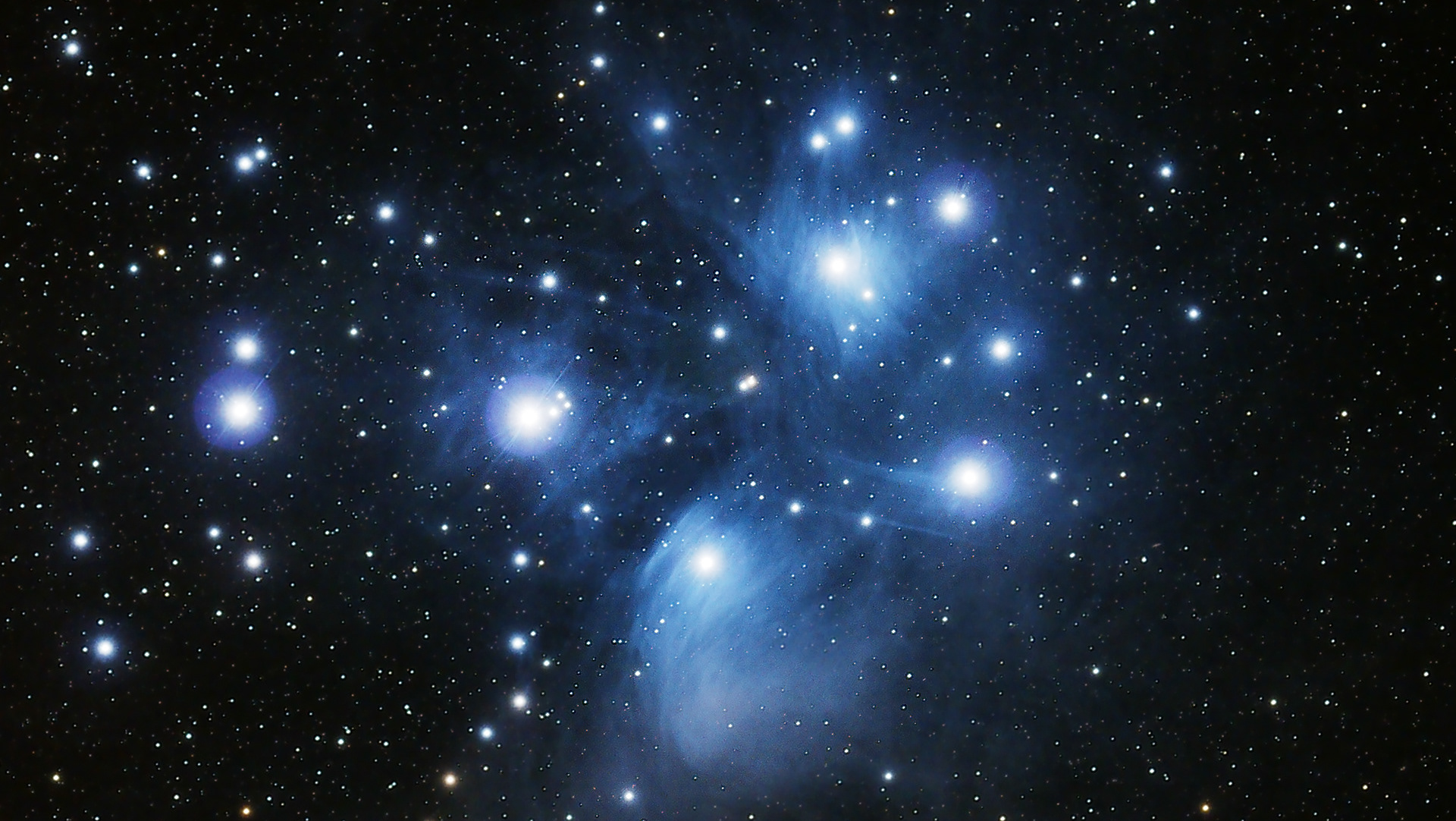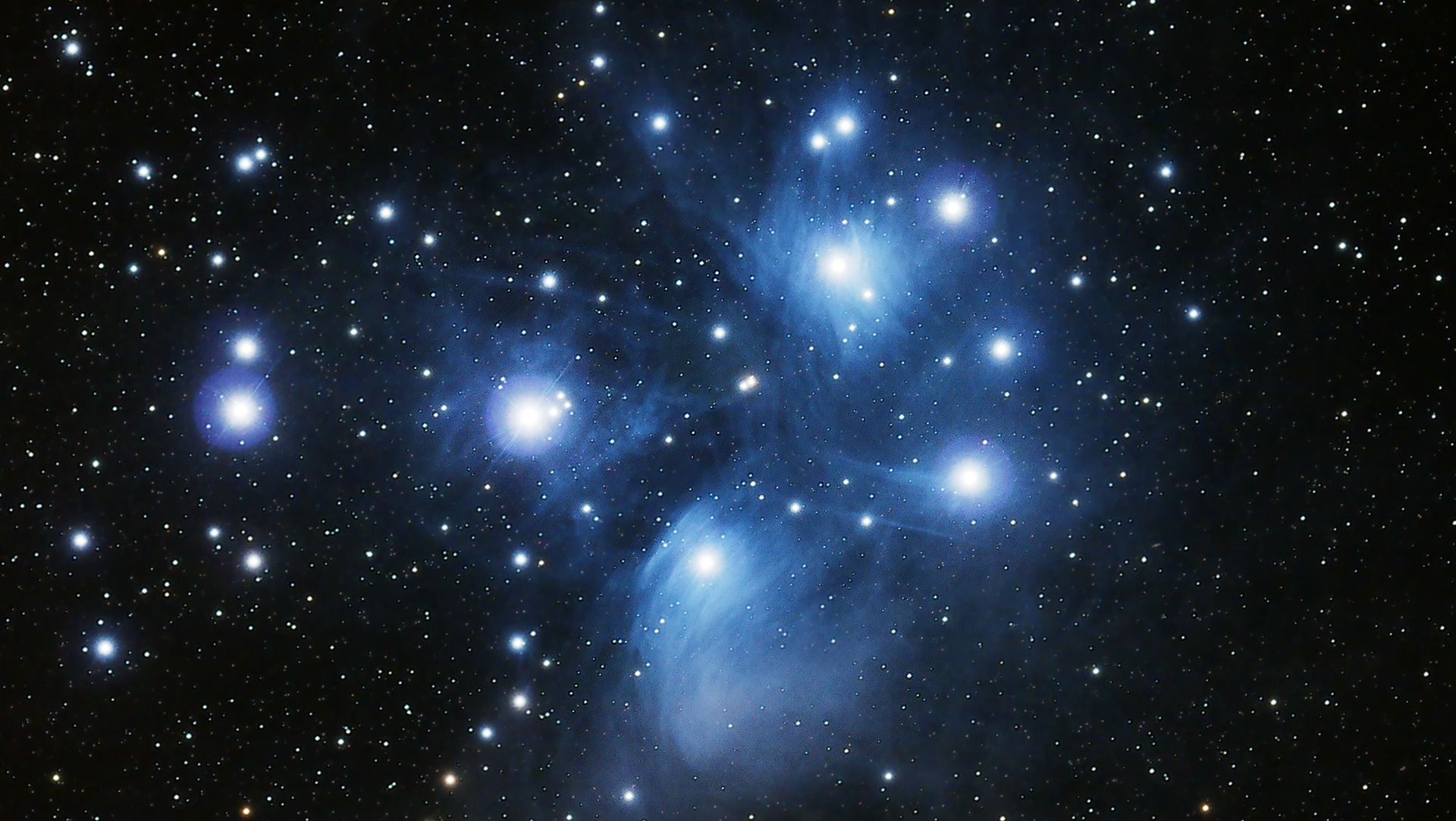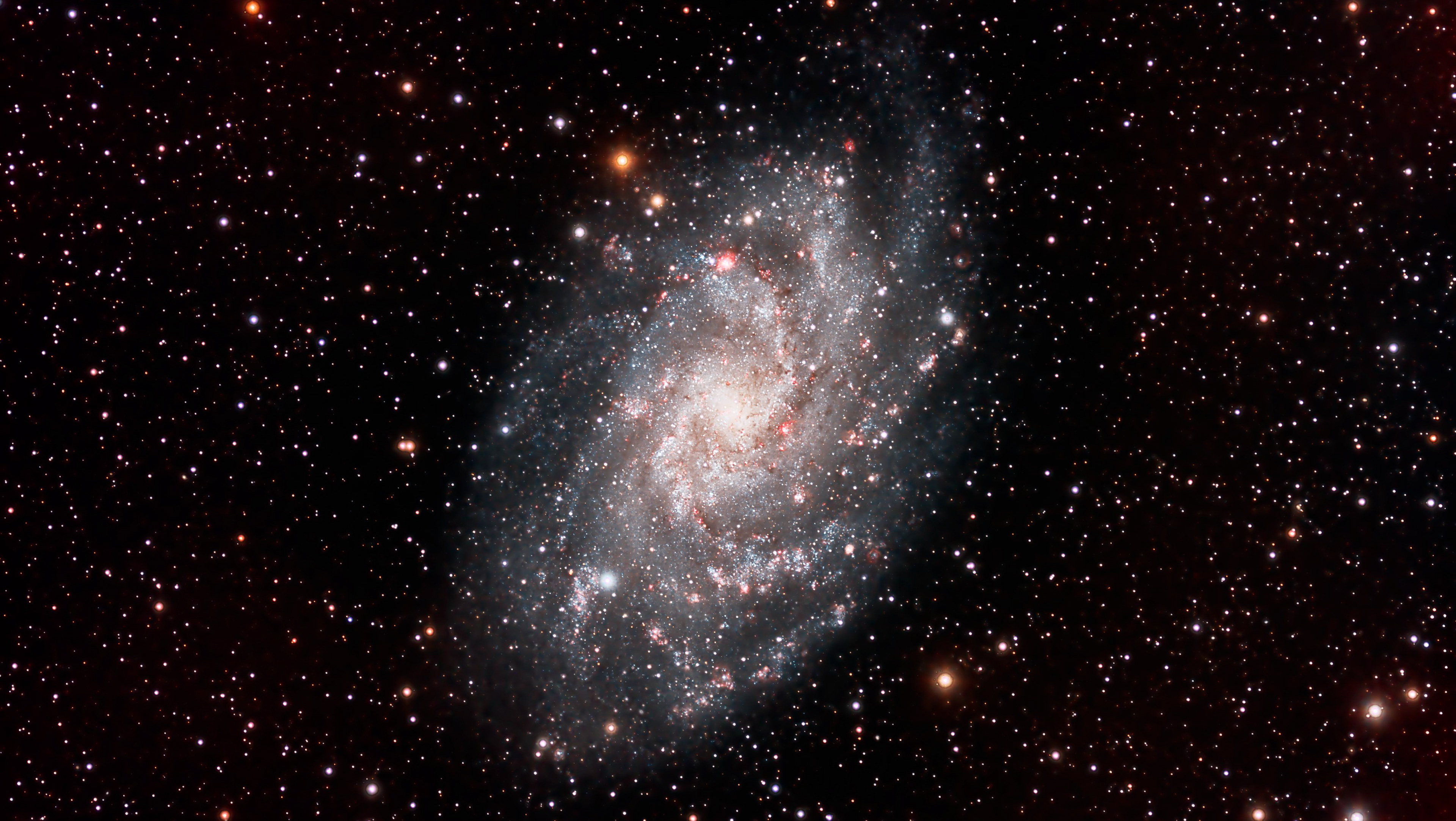
The Lobster Claw Nebula is the common name for the emission nebula Sh2-157, located in the constellation Cassiopeia. It is an HII region that glows due to ionized hydrogen (red) and oxygen (blue) gases. In the upper right is another interesting target, NGC 7635, also known as the Bubble Nebula. It is an H II region emission nebula and contains a "bubble", created by the stellar wind from a massive hot, 8.7 magnitude young central star.

LDN 673 is part of a giant cloud of dust and gas in the constellation of Aquilla. It is fragmented into many pieces, inside of which are forming stars. Some of these stars are illuminating parts of the nebula. This image was taken using LRGB filters, which means it is true color.

This is an image of the Flying Bat Nebula (SH2-120) and the Squid Nebula (Ou4). These nebulae lie about 2,300 light years away in the constellation Cepheus. The blue Squid nebula is the result of doubly ionized oxygen atoms while the orangish Flying bat nebula is the result of hydrogen emissions.

Barnard 150 (B 150) is a dark nebula located in the Cepheus constellation 1200 light years away from Earth. It is also known as the Seahorse Nebula or the Dark Seahorse Nebula due to its shape. Do you see it? This image is true color!

vdB 150 is a faint, blue reflection nebula located in the constellation Cepheus. It is also known, along with surrounding nebulae, as the Shark Nebula due to the overall shape the complex forms. The nebula is illuminated by a bright, blue-white star that causes the surrounding gas and dust to glow bluish. This is a true color image.

This is known as the Wolf Nebula, for obvious reasons! Recognize it? It's the previous Shark Nebula rotated.... I couldn't resist!

The Bubble Nebula (NGC 7635) is an emission nebula located in the constellation Cassiopeia. The nebula lies at a distance of 7,100 to 11,000 light years from Earth. It was nicknamed the Bubble Nebula because of its shape, which was created by a strong stellar wind from a young, massive, hot star that shed its material to form the nebula. The Bubble Nebula has an apparent magnitude of 10 and is about 10 light years in diameter. SHO

M1, the Crab Nebula. A difficult target to image due to its small size and relative low luminance compared to light polluted skies, M1 is a supernova remnant and pulsar wind nebula in the constellation of Taurus. It is located 6,523 ly from earth, 5.5 ly across, and is just over 1,000 years old. (A lightyear, ly, is 6 trillion miles) This photo was taken in the Mojave desert in Goffs, CA at the Mojave Desert Heritage and Cultural Association. Great dark skies, RV park and campground, and a fascinating museum of the Mojave region. (Celestron 8" SCT, SHO filters, 181 minutes total integration time).

IC417 Spider Nebula - the Spider is an emission nebula approximately 100 light years across. It is located about 10,000 light years from Earth. It is a hotbed of new star formation. This is a combination of both Ha and OIII to create a bi color image.

This colorful image is of the Gamma Cygni Nebula, also known as the Sadr Region or IC 1318. It is a diffuse emission nebula that can be seen around Sadr (Gamma Cygni), the star near the center of the image. Despite the name, the star and the nebula are unrelated. Even though it looks embedded in the nebulosity, Sadr is approximately 1,800 light years distant, while the nebula is much further away, at 4,900 light years. The Gamma Cygni Nebula is considered an emission nebula because it is ionized by the radiation of the nearby stars and it emits visible light as a result. The visible portion of the H II region stretches over an area more than 100 light years across. The nebula is illuminated by an O9-class star which is visually obscured by interstellar material.

The Veil Nebula is a cloud of heated and ionized gas and dust in the constellation Cygnus. It was formed by the expanding gasses of massive star that exploded, a supernova, about 8,000 years ago. The entire nebula is 110 light-years across, covering six full moons on the sky as seen from Earth, and resides about 2,100 light-years away. The different colors are from energized gases, predominantly Hydrogen, Oxygen, and Sulfur, each with its own emission color. Given the size of this object, this image is a mosaic of two images combined to cover the entire nebula.

The Omega Nebula, M17, also known as the Swan Nebula, Checkmark Nebula, Lobster Nebula, and the Horseshoe Nebula (really?) is a region in the constellation Sagittarius. It is an emission nebula, meaning it emits light instead of reflecting star light. This image is created using filters that allow the emitted light from excited Sulfur, Hydrogen, and Oxygen (SHO). These filters are assigned to the Red, Green, and Blue channels, respectively. This is how the Hubble images are acquired, as well! The nebula is 40 ly across, and has a total mass of 30,000 sun equivalents!

The Heart Nebula is an emission nebula located in the constellation Cassiopeia. It displays glowing ionized hydrogen gas and darker dust lanes, pinkish in the image. It is also made up of ionised oxygen and sulfur gasses, contributing the blue and orange colors. The shape of the nebula is driven by stellar winds from the hot stars in its core. Distance: 7500 light years Radius: 165 light years

The Cocoon Nebula in RGB. IC 5146 is a reflection and emission nebula in the constellation Cygnus, including a cluster of stars surrounded by a bright and dark nebula. This image was captured in 6 sessions from 2021 to 2024 and includes 437 separate Red. Green, and Blue images.

The Prawn or Shrimp Nebula (SH2-188) is an emission nebula located in the constellation Scorpius. It has an apparent magnitude of 7.31 and lies at a distance of 6,000 light years from Earth. Located to the south of Antares, the nebula is about 250 light years in diameter, corresponding to an apparent size of 1.5 degrees, or 3-4 times the size of the full Moon. LRGB

The Eagle Nebula (M16) is a star forming region located in Serpens. It is a well-known emission nebula surrounding a young open star cluster. Messier 16 is best known for the famous Pillars of Creation, a region where intense star forming activity is taking place. The region was imaged by the Hubble Space Telescope in the 1990s. The Eagle Nebula in fact contains several active starburst regions. The Eagle Nebula was named for its shape, which resembles that of an eagle. SHO

SH2-132, also known as The Lion Nebula (can you see the lion?), is a rich HII region with star clusters, emission nebulae, and dark dust regions. Located in the southern portion of the constellation Cepheus, the Lion Nebula is roughly 10,00 light-years away in the Perseus Arm of the Milky Way Galaxy. This is primarily an emission nebula with some massive stars responsible for ionizing the gas in this region. In particular, two Wolf-Rayet stars have been identified - with the designation HD 211564 and HD 211853. Wolf-Rayet stars are huge and hot and have a white-blue coloration. These stars are at least 20 times more massive than our Sun and can be hundreds of thousands or even millions of times brighter! In addition, they tend to be eruptive and possess extremely high solar winds. This whole region is believed to be an area of new star formation.

The Ghost Nebula (SH2-136) is a reflection nebula located approximately 1,470 light-years away in the constellation Cepheus. The nebula’s dust and gas form eerie-looking figures that resemble ghosts. The Ghost Nebula spans more than 2 light-years. It is illuminated by several nearby stars. These clouds contain several young stars whose light makes the nebula glow in brownish tones. SHO

The eyelike photo is of the Helix Nebula, a Planetary nebula about 10,000 years old and 600 ly away. Captured in Sequoia National Park. 9/2018

The Helix Nebula (NGC 7293) in NB is a planetary nebula located 650 light years from Earth in the constellation Aquarius. It is one of the closest planetary nebulae to Earth, as well as one of the brightest. Its striking appearance has earned it the nickname the Eye of God Nebula. Planetary nebulae like the Helix are formed when stars that are not massive enough to go out as supernovae expel their outer envelopes at the end of their evolutionary cycles. The stars become white dwarfs – hot remnant stellar cores – that energize the ejected material. White dwarfs are very dense, typically packing a mass similar to that of the Sun into a volume comparable to that of the Earth. The intense ultraviolet radiation from these stars causes the ejected layers of gas to glow. The Helix Nebula is believed to have formed about 10,600 years ago, when the central star, catalogued as GJ 9785, reached the end of its life cycle and shed its outer layers into space. HOO

M20, the Trifid Nebula. The Trifid Nebula is a rare combination of three nebulae types that reveal the fury of freshly formed stars and point to more star birth in the future. 8" SCT; ZWO 1600MM Pro — at Los Angeles Astronomical Society.

The Trifid Nebula (M20) in NB is a large star-forming region located in the constellation Sagittarius. The nebula’s name means “divided into three lobes,” and refers to the object consisting of three types of nebulae and an open star cluster. The open cluster is surrounded by an emission nebula, a reflection nebula, and a dark nebula within the emission nebula that gives M20 the trifurcated appearance for which it is known. It has a diameter of 42 light years and lies at a distance of 5,200 light years from Earth. SHO

Simeis 57, the Propeller Galaxy, is part of a vast and rich HII-region in Cygnus, known as Cygnus X Complex. It was catalogued first in the early 1950s by astronomers at the Crimean Astrophysical Observatory at Simeiz, Ukraine, as the 57th object in a catalogue containing 306 HII regions.

The Rosette Nebula is an H II region located in the Monoceros region of the Milky Way Galaxy. The open cluster NGC 2244 is closely associated with the nebulosity, the stars of the cluster having been formed from the nebula's matter. The radiation from the young stars excites the atoms in the nebula, causing them to emit radiation themselves producing the emission nebula we see in this LRGB image. A survey of the nebula with the Chandra X-ray Observatory has revealed the presence of numerous new-born stars inside optical Rosette Nebula and studded within a dense molecular cloud. Altogether, approximately 2500 young stars lie in this star-forming complex. Distance: 5000 light years Radius: 65 light years

The Tulip Nebula (Sh2-101) is an emission nebula located in Cygnus constellation. It lies at an approximate distance of 6,000 light years from Earth and has an apparent magnitude of 9.0, and a diameter of about 70 light years. The HII region is called the Tulip Nebula because its shape resembles the form of a tulip. The emission from the Tulip Nebula is powered by ultraviolet radiation of a hot young star. In images, it can be seen near the nebula’s center. HOO

IC405 Flaming Star Nebula - an emission and reflection nebula surrounding the bluish, irregular variable star AE Aurigae. It shines at magnitude +6.0. The nebula measures approximately 37.0' x 19.0', and lies about 1,500 light-years away from Earth. The nebula is about 5 light-years across. It is located about 10,000 light years from Earth. It is a hotbed of new star formation. This is a combination of Sulfur, Ha and OIII (SHO aka Hubble Palette) to create a color image.

IC410 is a dusty emission nebula located in the constellation of Auriga at about 12.000 ly from Earth. The gas structures in this picture are lit by the radiation from the open star cluster NGC1893 that lies in the center of the nebula. This star cluster is about 4 million years old, but in astronomical terms it is still very young, with hot, massive stars. At the bottom-right of the star cluster two more dense structures are visible. These are similar to the famous Pillar of Creation and they are composed of dust and gas leftover from the formation of the star cluster and are very likely to give birth to more stars in the future. The tadpoles are formed from the stellar winds and radiation pressure from the stars in NGC 1893.

IC 443 Jellyfish Nebula - a galactic supernova remnant in the constellation Gemini. near the star Eta Geminorum. Its distance is roughly 5,000 light years from Earth. IC 443 may be the remains of a supernova that occurred 3,000 - 30,000 years ago. It is located about 10,000 light years from Earth. It is a hotbed of new star formation. This is a true color combination using L-R-G-B filters.

IC 443 Jellyfish Nebula in NB - a galactic supernova remnant in the constellation Gemini. near the star Eta Geminorum. Its distance is roughly 5,000 light years from Earth. IC 443 may be the remains of a supernova that occurred 3,000 - 30,000 years ago. It is located about 10,000 light years from Earth. It is a hotbed of new star formation. This is a combination of both Ha and OIII to create a bi color image.

A photo of M42, the Orion Nebula, taken on a hazy, partially clouded night in Lockwood Valley. Tried out my recent Craigslist purchase of a 5" achromatic refractor for $200! Guess it works, since this was taken under poor conditions.

Flame and Horsehead Nebulae

NGC 2359 Thor's Helmet - an emission nebula in the constellation Canis Major. The nebula is approximately 11.96 thousand light years away and 30 light-years in size. The central star is the Wolf-Rayet star WR7, an extremely hot star thought to be in a brief pre-supernova stage of evolution. It is similar in nature to the Bubble Nebula, but interactions with a nearby large molecular cloud are thought to have contributed to the more complex shape and curved bow-shock structure of Thor's Helmet. It is located about 10,000 light years from Earth. It is a hotbed of new star formation. This is a combination of both Ha and OIII to create a bi color image.

The Crescent Nebula is an emission nebula in the constellation Cygnus, about 5000 light-years away from Earth. The wavey "texture" is from the collision of stellar winds, like our solar winds, from two different stars, each exciting the other to glow. This image was made from only the light from Hydrogen and Oxygen, two different wavelengths.

Sh2-106 is an emission nebula and a star formation region in the constellation Cygnus. It is a H II region estimated to be around 2,000 ly from Earth, in an isolated area of the Milky Way. Weird, but pretty, huh?

SH2-155, aka the Cave Nebula. This collection of Hydrogen (H2), Oxygen (OIII) and Sulphur (SII) isotopes is a diffuse nebula located 2400 lightyears from earth. The images were collected from 9/21-12/21 using a Celestron 8" SCT telescope, a ZWO 1600mm Pro camera, and an Ioptron CEM70g mount. Integration times: H2, SII - 4 hours, OIII- 5 hours using the Hubble SHO palette.

Ever wonder what you could see if you had very sensitive eyes? This shot was taken with a Canon 70mm lens, which is just a little more magnification than your eyes. So, a wide field shot. The only difference is this is a long exposure. At the center are a couple famous nebulae - the North America and The Pelican. — at Los Angeles Astronomical Society.

The North America Nebula (NGC 7000) in SHO is an emission nebula in the constellation Cygnus. It is named because its shape resembles North America. It glows because the Hydrogen, Oxygen and Sulphur gases are ionized by stars which causes them to glow. Distance: 2,590 light years Radius: 90x140 light years

Christmas Tree Cluster

The Cone Nebula is an H II region in the constellation of Monoceros. The nebula is located 2,700 light-years away from Earth, and is 4 light years across. A ly is 5,878,600,000,000 miles!!

M8, the Lagoon Nebula. Mostly hydrogen gas, which is associated with star formation. Just over 4,000 light years from earth.

M27, the Dumbbell Nebula is a planetary nebula in the constellation Vulpecula, at a distance of about 1227 light-years. 8" SCT; ZWO 1600MM Pro — at Los Angeles Astronomical Society.

California Nebula in Ha

The Iris Nebula is a bright reflection nebula in the constellation Cepheus. The nebula, which shines at magnitude +6.8, is illuminated by a magnitude +7.4 star.

The Elephant's Trunk Nebula, near the upper left, is a concentration of interstellar gas and dust within the much larger ionized gas region IC 1396 located in the constellation Cepheus about 2,400 light years away from Earth.

Pacman Nebula Taken with 8"SCT, ASI1600mm Pro and LRGB

Ring Nebula

M97, the Owl Nebula — at Lockwood Valley, California.

Wizard Nebula SW 80mm EDO Pro, ASI1600mm Pro, Ha/OIII/Si2 — in Bakersfield.
